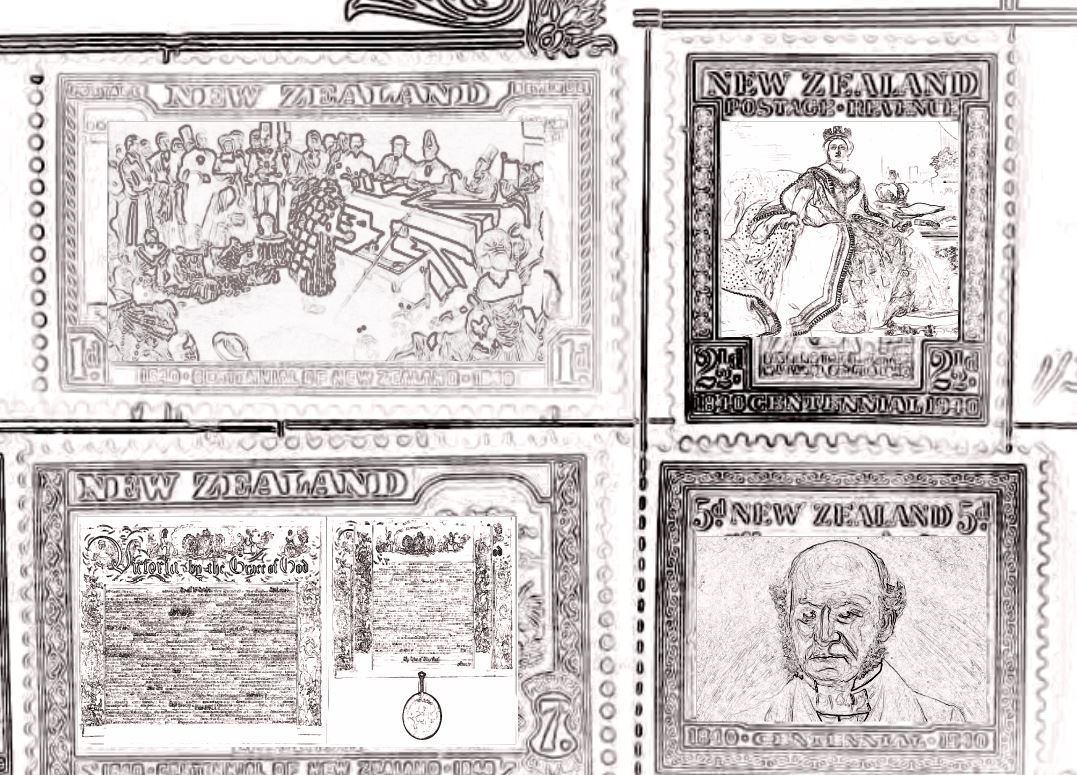Summary Version of a Heretical Trailblazing Essay
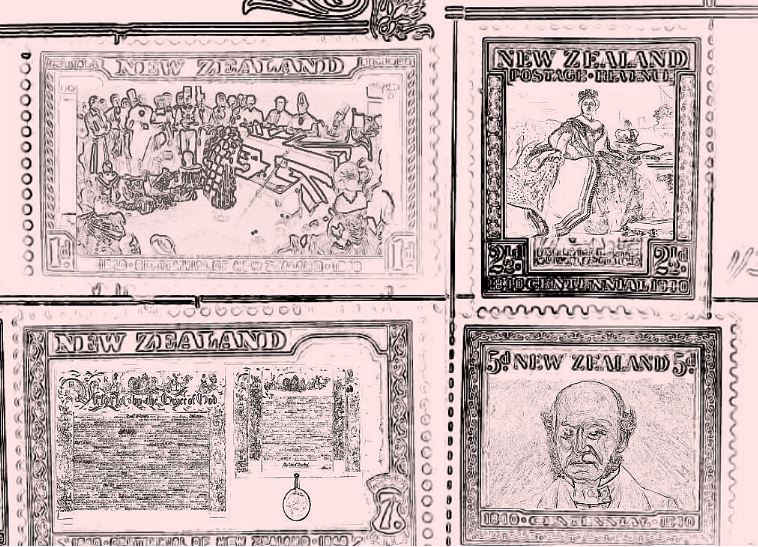
In this summary of the groundbreaking heretical essay, “Deep History of Waitangi: The Queen Victoria Connection”, Steve ‘Snoopman’ Edwards proves that the British takeover of Aotearoa New Zealand in 1839 and 1840 occurred by the two parallel tracks — a ‘Treaty Theatre Track’ and a ‘Colonial Law Track’. This geo-political gambit to win paper sovereignty over a new territory occurred with the exercise of Royal Prerogative Powers, innovative political theater and weaponized time to avoid authorization from the British Parliament, legal challenges in English courts and embarrassment for the British Monarch.
The Treaty Theater Track provided the cover story to construct the appearance that the 1840 Waitangi Treaty was the mechanism via which paper sovereignty was gained. When, in fact, paper sovereignty was gained by the ‘Colonial Law Track’, comprised of legal instruments consistent with English Constitutional Law. Hence, the Treaty was a red herring literary device, while the travelling ‘Treaty Theatre Company’ served as a Deus Ex Machina plot device that unexpectedly resolved an ‘impossible impassé’.
On June 15th 1839, New Zealand was acquired by the British Empire on the basis of occupation, when the South Pacific archipelago became a dependent colony of New South Wales by Letters Patent of Boundary Extension. The paper heist of sovereignty was ratified on 16th November 1840 by a Letters Patent of Severance — that was authorized by Queen Victoria with the Royal Privy Seal — and which established New Zealand as a separate colony.
The accompanying Letters Patent device to erect a separate colony was timed to occur after the treaty sheets arrived in London — to make it appear the Treaty was the means by which sovereignty was acquired. Once Queen Victoria’s Letters Patent of Severance and the Royal Charter of New Zealand were ratified with the Privy Seal of the United Kingdom, the British Crown’s title became unchallengeable by British subjects under English Constitutional Law, and was recognized by other nations under International Law.
By this heist of power, the British Monarch authorized innovative cunning tricks in statecraft to gain full paper sovereignty over an entire indigenous people that could never be repeated, lest the perfect crime became obvious. The decision to opt for a Treaty was pursued to save face for the British Monarch, by achieving the appearance of sovereignty cession to Queen Victoria. If the 1840 Waitangi Treaty had been the only device for gaining paper sovereignty, the ‘agreement’ alleging full, free and willing transference of sovereignty from an entire indigenous people to the British Monarch and her heirs and successors forever, would have become challengeable in the courts.
By Steve ‘Snoopman’ Edwards, 22 January 2022

➼ British Takeover by Two Parallel Tracks
In 1839, by her royal seal, Queen Victoria authorized the perfect power crime to swindle full sovereignty from an entire indigenous people by pen-quill, parchment paper and treaty theater for the expansionist British Masonic Empire.
It turns out that the British Crown acquired the islands of Aotearoa New Zealand on the basis of occupation and wrested paper sovereignty by usurpation via a parallel ‘Colonial Law Track’ — rather than the 1840 Waitangi Treaty.
The legal instruments that activated this stealthy heist of power included proclamations, new commissions, swearing-in officials, letters patent, legislation, gazetted notices and a royal charter that solidified the establishment of New Zealand as a separate colony of the British Masonic Empire.
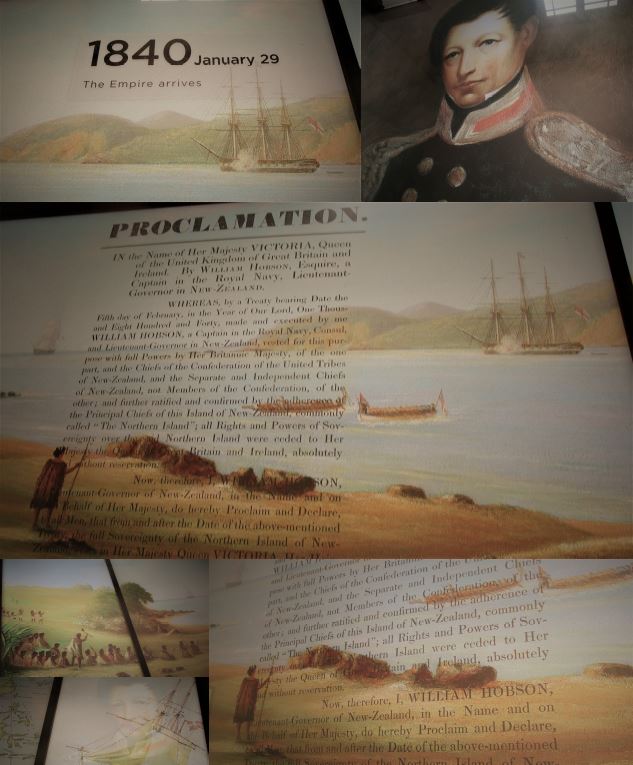
Meanwhile, a Treaty Theatre Track was laid to supply the documentation to create the nation’s founding myth: cession by treaty.
In deed and in design, the 1840 Waitangi Treaty parchments were spun with unseemly speed on a fulcrum of deceptive language translation differences, poorly recorded oral promises and a simulation of a ‘sacred covenant’.
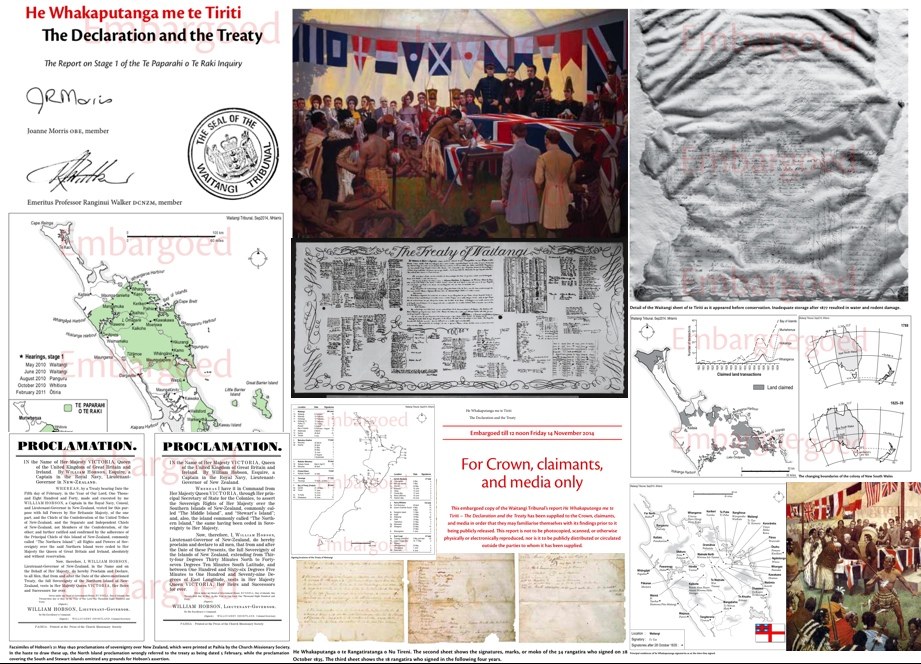
And, in the language of the imperial power, sovereignty was construed to be willingly transferred — as Māori from pā to parliament to prison today all well know.
And – all the while the British Crown, then and now, contrives ignorance.
A whirlpool was sensed by Prophet Penetana Papahurihia after the first signings of the 1840 Waitangi Treaty, which he said would keep Māori captured in its torgue for beyond 200 hundred years until a time when the truth would be commonly known and the legacy of hidden tricks over-turned. The shrewd political chess moves have been tracked back to their imperial source in my heretical trailblazing illustrated essay, “Deep History of Waitangi: The Queen Victoria Connection”.

In this summary article of the full essay, Deep History of Waitangi, I sketch how Britain’s acquisition of New Zealand on June 15th 1839 by Letters Patent of Boundary Extension, was the mechanism to initiate a series of legal instruments that were deployed along a Colonial Law Track to usurp paper sovereignty.
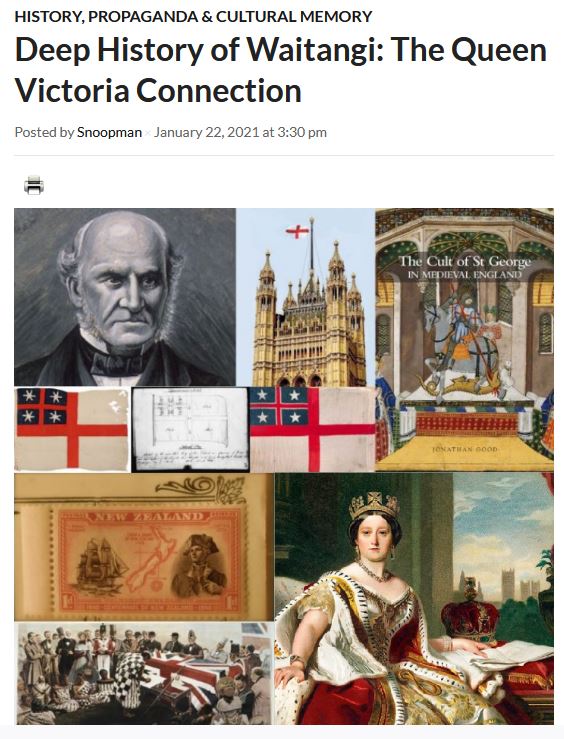
With the callous trickery, an ingenious théâtre usurp d’état was orchestrated to switch between two parallel tracks, that involved a travelling Treaty Theatre Production on one track, while upon the other track, the legal mechanisms consistent with English constitutional law were transported to deliver a new colony to the British Masonic State.
The metaphorical ‘stage’ of the travelling Treaty Theatre Production, essentially, spun on a fulcrum of language translation differences, with predictable cultural disparities between the written and oral agreements as part of the semi-improvized performances.
The simulation of a sacred covenant was ‘marketed’ with the persuasive manipulation of Protestant missionaries, whose emotional hijacking acted as ‘powerful auxiliaries’ — as expected — to leverage Captain William Hobson’s direction of a Waitangi Treaty Cliqué.
This stealthy operation, authorized by Buckingham Palace, weaponized the physical dimension of time to wrest control of another territory on the grand planetary chessboard.
On June 15th 1839 — when Queen Victoria’s Royal Prerogative Powers, were activated to authorize the perfect power crime of statecraft with the novel twist of swindling full sovereignty from an entire indigenous people — New Zealand was acquired by the British Empire on the basis of occupation.
In this devious way, the South Pacific archipelago became a dependent colony of New South Wales by the first of the series of colonial law devices, the Letters Patent of Boundary Extension. By this imperial chess move, the Letters Patent of Boundary Extension, expanded the jurisdictional boundary of New South Wales to include all of New Zealand.
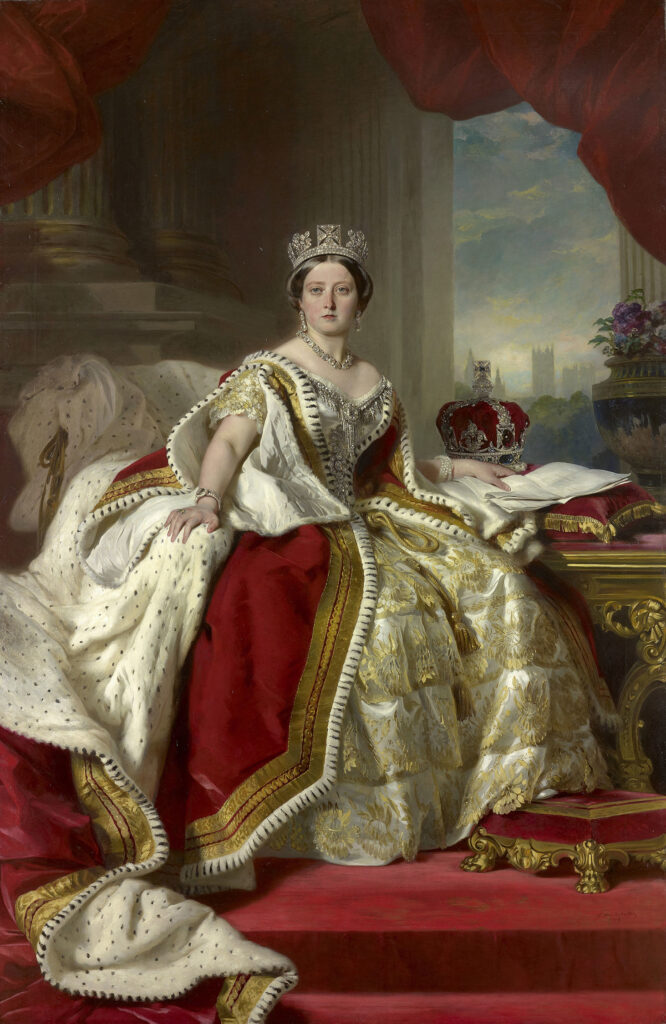
This parallel track was detected by Norman Arthur Foden, whose 1938 work — The Constitutional Development of New Zealand in the First Decade (1839-1849) — proved that New Zealand was acquired on June 15th 1839 by the British Empire on the basis of 2000 Britons settled in New Zealand.
By means of a Letter Patent device to erect a dependent colony, the British Crown adopted the unauthorized British settlements, and therefore the usurpation of sovereignty was wrested through subsequent Colonial Law Track legal moves.
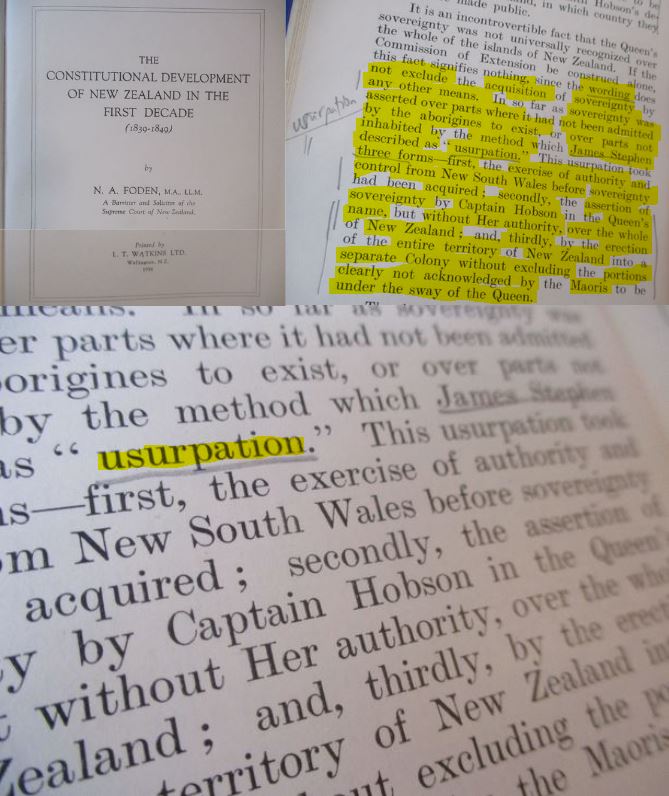
But, the British takeover of New Zealand still required trickery.
More precisely, a théâtre usurp d’état was opted for, in which a cliqué formed to orchestrate, in essence, a Treaty Theatre Production Company that would script the trickery, hire a theatrical troupe and commandeer improvisational actors to assist in the mission to persuade.

To this devious end, Hobson’s Commission was authorized on 30th July 1839 by Lord Normanby on Her Majesty’s Command at the Court of Buckingham Palace, with the device of Letters Patent. The method of acquisition was neither stated in this Letters Patent of 30th July 1839, nor in the Letters Patent for Boundary Extension, dated 15th June 1839.

Treaty Theatre Track – From Busby’s Dream Job to Te Tiriti o Waitangi 1840
The origins of the Treaty Theatre Track can be traced back to June 1831 when future British Resident James Busby essentially outlined his dream job description to make treaties with Māori.
Britain’s first official, James Busby, incrementally drew rangatira into Britain’s expansionist maritime jurisdiction. First, by conning chiefs in 1834 to select a flag of national shipping that displayed England’s orientalist St George’s Cross, to save Māori from the maw of British Maritime Law. Two Māori ships had been impounded at Port Jackson, Sydney, for failing to fly a national flag.
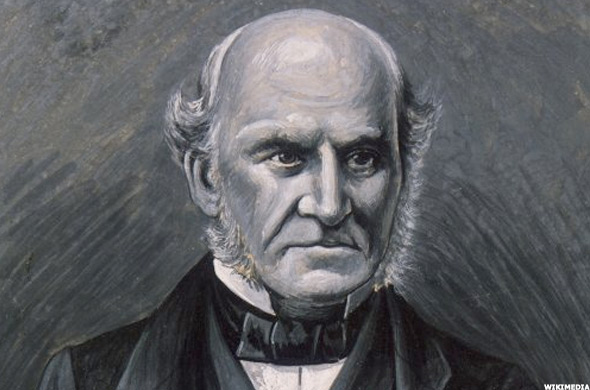
Second, Busby gained the cooperation of 12 chiefs to assist in the first official British-endorsed land confiscation, eviction and village razing by fire in 1834, which established a parcel of land named England, after antagonizing Chief Rete by bossing him and his hapū around about how to conduct their logging commerce.
And then, thirdly, Busby conned rangatira to sign the 1835 ‘Declaration of Independence of the United Tribes of New Zealand’, to create the edifice of an ‘independent state’, for its later deconstruction.
Indeed, the 1835 ‘Declaration of Independence’, or He Whakaputanga o te Rangatiratanga o Nu Tireni, was designed to lure Māori chiefs into a British Protectorate jurisdiction, and to forestall French missionary influence, as part of a long-game to perfect the incomplete title claimed by Freemason Bro. Captain James Cook, by stealthily gaining full paper sovereignty by a hidden track.
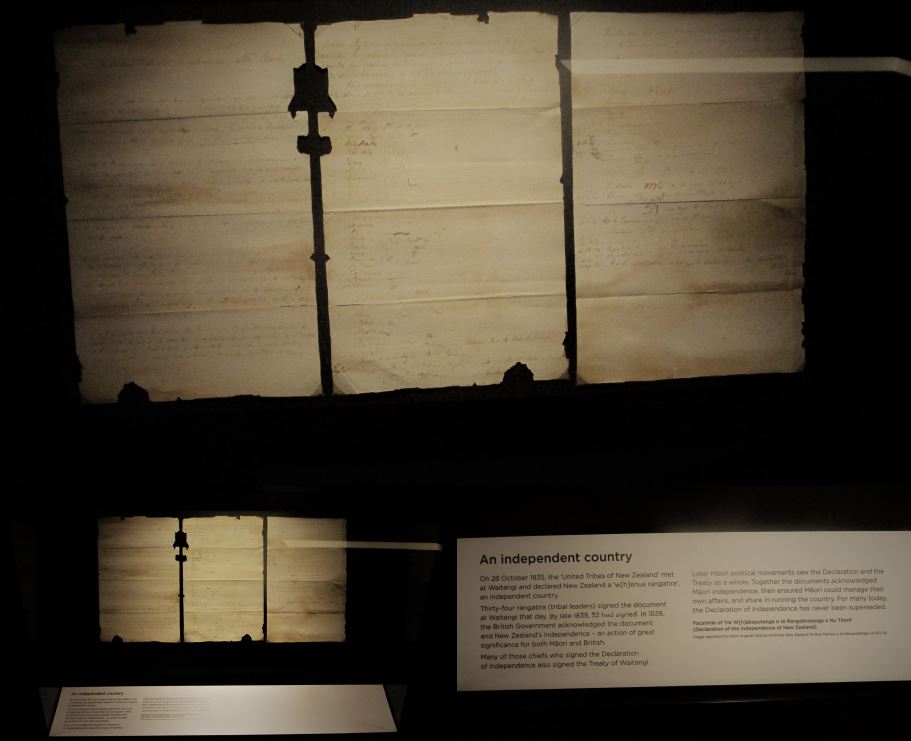
The Treaty Cliqué at the scene of the 1840 Waitangi parchment crime included: Royal Navy Captain William Hobson, who convened a conclave of Protestant Missionaries aboard the ship, Herald; the primary drafter of the English text, British Resident James Busby after Captain Hobson’s Chief Clerk, James Freeman, wrote an initial draft; and the primary translator of the text into Māori, Church of England Reverend Henry Williams, with the assistance of his son Edward, and Reverend Richard Taylor, who hand-wrote the final Māori language copy on February 5th.
This Cliqué also included: Surveyor-General Felton Mathew; the CMS Missionaries, William Colenso, Charles Baker and George Clarke, and French Catholic Bishop, Jean Baptiste Pompallier.
Remotely, the Treaty Cliqué included: Secretary of State for War and the Colonies, Lord Normanby and his successor, Lord John Russell; Governor of New South Wales George Gipps; the Secretary of State for Foreign Affairs, Lord Bro. Palmerston, the world’s High Priest of British Freemasonry; and Queen Victoria of the House of Saxe-Coburg and Gotha.
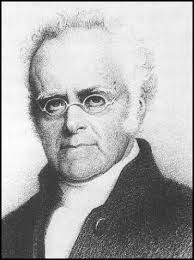
To the key people present aboard the Herald and in the Waitangi Treaty tent in early February of 1840, the deception that sovereignty would be lost in translation was obvious to those who were either fluent in both languages, or privy to the discussions.
The confidence trick rested on the fact that Māori were not fluent in English at that time.
The ruse could not work, if anyone spelt out to Māori that the respected Reverend Henry Williams, as chief scribe of the Māori language version, had switched words to hide the swindle of sovereignty.
In Article One of the Māori language Te Titiri o Waitangi o 1840, the chiefs conferred the right of governorship, meaning authority was granted to the Queen to appoint a Governor to rule over Pākehā only.
Meanwhile, in the English text, the chiefs signed away, or ceded, complete sovereignty over their territories. Rev. Henry Williams achieved this sleight of hand by rendering Kawanatanga or governorship to mean sovereignty. The effect was that Kawanatanga was essentially construed to mean that Māori ceded sovereignty over New Zealand to the Queen of England, and to her heirs — forever!
Māori chiefs thought they retained their chieftainship, or independent authority, with the crucial term — tino rangatiratanga — in Article Two of the Māori language version. Both mana and tino rangatiratanga were regarded as paramount, spiritually sanctioned, inalienable power, as Emily Blincoe noted in her law paper, “The Myth of Cession: Public Law Textbooks and The Treaty of Waitangi”.
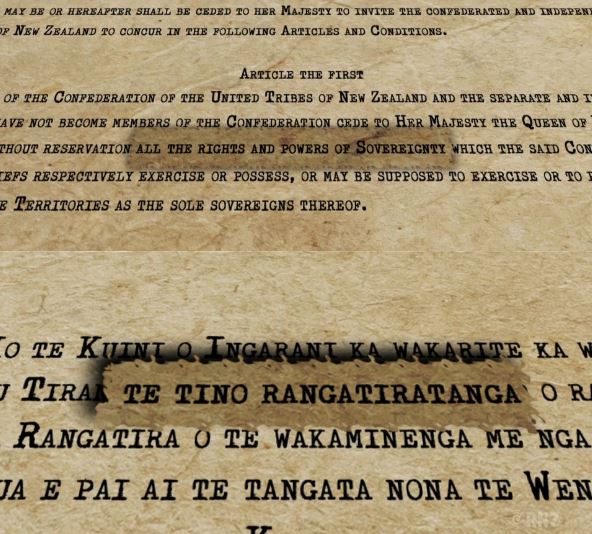
Moreover, Māori at Waitangi were unaware that a secret piece of international law, known today as the Doctrine of Discovery, was applied during the 1840 Waitangi Treaty Theatre. This Discovery Doctrine was ‘transported’ on both tracks — the Colonial Law Track and the Treaty Theater Track — that intersected briefly at Waitangi, where time had been weaponized to gain control over a new territorial-jurisdictional space for the British Masonic Empire.
The Discovery Doctrine — whose roots have been traced to the Catholic Church when the Vatican envisaged a universal empire during the Crusades — held that indigenous people living in the New World were deemed too ‘primitive’ to be considered ‘sovereign’ because they lacked Christian mythology and therefore had no legitimate legal or political status.
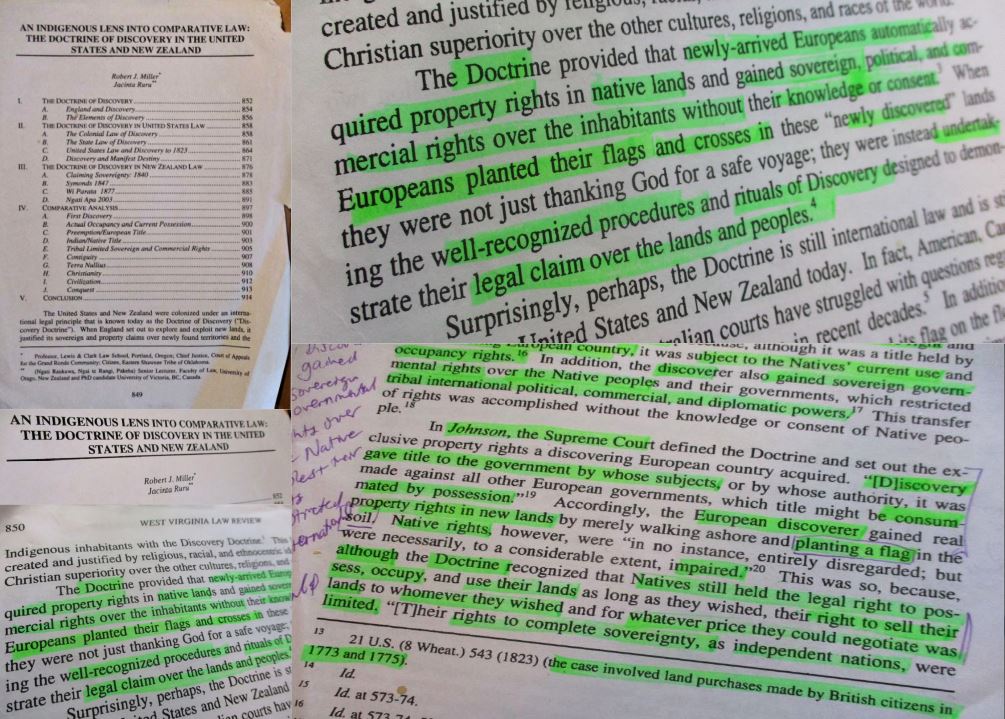
European nations further developed the Discovery Doctrine in the 15th Century, from whence they were forging maritime empires, and was designed to mitigate the chances of competing nations making expensive war with their technologically-even European competitors at the cost of much ‘blood and treasure’. The European Maritime Powers thought it would be easier to gain territory off ‘New World’ indigenous peoples — whom were cast as ‘savages’ — since they lacked cannons.
Indigenous law scholar Professor Robert J. Miller identified ten Doctrine of Discovery elements in his 2006 book titled, Native America, Discovered and Conquered. The ten Doctrine of Discovery elements are: (1) First Discovery; (2) Actual Occupancy and Current Possession; (3) Preemption/European Title; (4) Indian Title; (5) Tribal Limited Sovereign and Commercial Rights; (6) Contiguity; (7) Terra nullius; (8) Christianity (9) Civilization; and (10) Conquest.
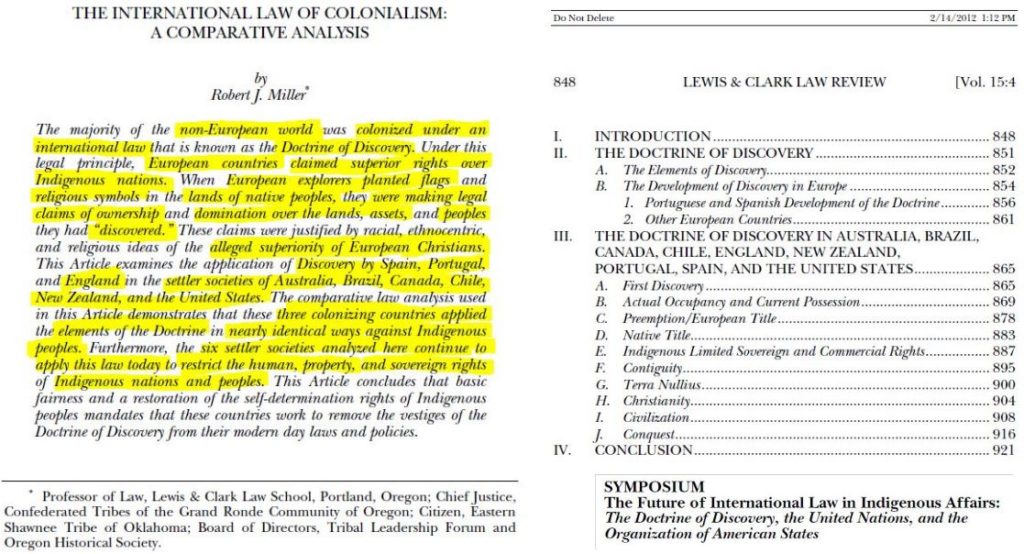
This addition to colonization scholarship provides the analytical tools to categorize the phenomena as a mindset that underpinned the motives, means and modus operandi. As such, these Discovery elements are identified in the full version of my illustrated essay, “Deep History of Waitangi: The Queen Victoria Connection” — as they surface.
These Discovery Doctrine elements are present in the circumstances, texts and intent of the earlier 1835 ‘Declaration of Independence’ and the 1840 Waitangi Treaty.
For example, in Article Two of both Treaty texts, Queen Victoria upheld the chieftainship over lands, village estates and treasures, while in the Māori language version the British Monarch gained the right to appoint an agent to barter or trade in land. However, the Second Article’s English text conferred the Queen of England the right of pre-emption, which was said to mean granting the exclusive right to purchase Māori lands at agreed prices. This exclusionary blackballing right of pre-emption was poorly understood by rangatira.
This Discovery element of Preemption/European title was a powerful mechanism since it not only created a monopoly for the British Masonic Empire over private British enterprises.
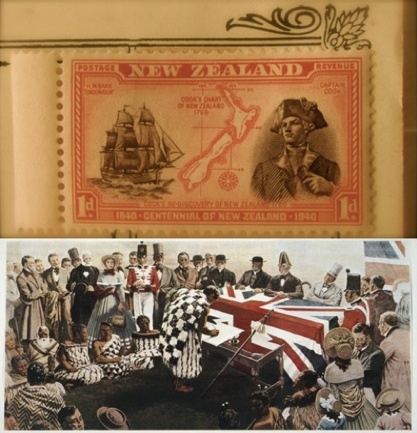
By appearing to gain this right, the British Crown constructed the capacity to extinguish Native Title created on First Discovery. Native Title rights would otherwise have the potential to last forever if indigenous nations never consented to sell to the European Maritime Power claiming the exclusive Preemption/European title right.
The Second Article also foreclosed rival European Maritime Powers from gaining this right. This Pre-emption right constructed a Crown land-acquisition monopoly, which would mean Māori would bare the burden of being coerced to sell lands at low prices in a new colonial economy where the profits from re-selling land at inflated prices would supply money for public works and emigration. In effect, Māori land owners were forced to ‘pay’ a kind of capital gains tax, as Keith C. Hooper and Kate Kearins found in their study, “Substance but not form: capital taxation and public finance in New Zealand, 1840-1859” published in the Journal of Accounting History.
The objective of the pre-emption rights was to provide a mechanism to transform the nominal paper sovereignty into substantive sovereignty over the soil. This Discovery element of Preemption/European title was a powerful mechanism since it not only created a monopoly for the British Masonic Empire over private British enterprises. By appearing to gain this right, the British Crown constructed the capacity to extinguish Native Title created on First Discovery. Such Indian or Native Title rights would otherwise have the potential to last forever if indigenous nations never consented to sell to the European Maritime Power claiming the exclusive Preemption/European title right.
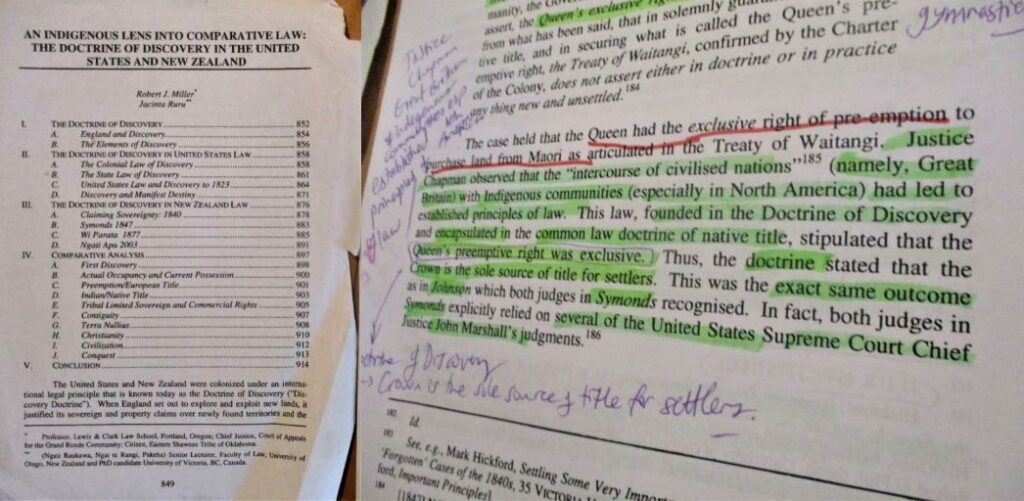
Therefore, the Discovery Doctrine sub-field supplies a sharpened lens to explain why the 1840 Waitangi Treaty as a so-called ‘compact’ or a claimed ‘agreement’, between two peoples had no in-built longevity from the colonizing power’s perspective.
Except, as a mechanism that purported the territory had been willingly ceded without coercion, to the British Monarchy in the English language version.
To this devious end, the lengthy 217-word sentence that comprises the Preamble of the English version, Queen Victoria was alleged to have extended “Her Royal favour” to invite the Aborigines to cede sovereign authority to her, and signaled the formation of Civil Government and also justified this move to avert evil consequences of unregulated emigration. This rambling Preamble stated Her Majesty was “anxious to protect … [the] just Rights and Property” of the “Natives Chiefs and Tribes of New Zealand”.
The politically hygienic rhetoric was plagiarized from Lord Normanby’s instructions of July 30th 1839 to Captain Hobson on his mission to Treat with Māori.
In other words, the Treaty would save face for the Monarch, at a time when annexations drew rebuke while time was ‘bought’ to establish a power structure that could better manipulate the structural forces of immigration, technological advancement and economic dynamism — after an inevitable violent consolidation stage.
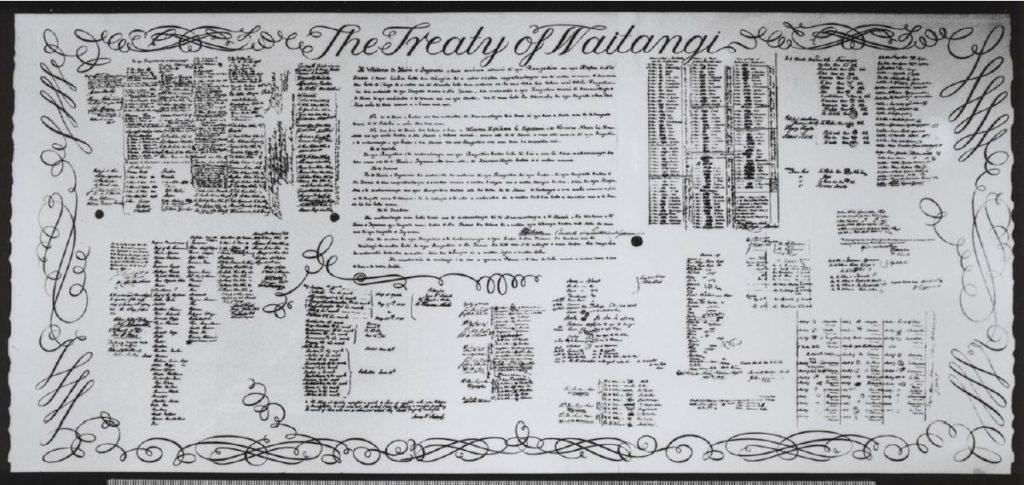
Normanby’s propagandist instructions implicitly ordered Hobson to lie by omission, talk up the benefits and emotionally hijack rangatira and chieftainesses and their hapū with the novelty of contact, including presents of tobacco and blankets. The details of how exactly Hobson & Co would pull off the epic swindle would be left to that part of the Treaty Cliqué that were in, or would travel to, the South Pacific.
Four ‘Clanker Moments’ at Waitangi demonstrate that a Treaty Cliqué consciously avoided fully disclosing to Māori there was trickery afoot, while the ‘theatre production’ proceeded with unseemly haste.
The contextual facts of these clanker moments remained unspoken at Waitangi and, therefore, they remained ‘at-large’ for historians to piece together later. Until now, however, the four clanker moments have not been identified as such, and their deep significance reveals the rivalry between four the competing powers — Britain, France, America and the Vatican — that intersected at Waitangi.
On February 5th, the first ‘clanker moment’ came when Chief Te Kemara of Ngāti Rāhiri hapū complained that the Anglican missionary Williams family had swindled him out of his land, and as well as Busby for swindling him of the land at Waitangi.
Ngāti Rāhiri were, in effect, hosting the hui since the meeting was technically and ironically on their land, but exclusively claimed by Busby. Chief Te Kemara’s rebuke was part of an opening volley that included chiefs Rewa and Moka, who focussed their anger on land loss, as part of a broader ill-conceived political strategy to bind Captain Hobson as governor to the Bay of Islands. This opening volley touched upon the matter of land loss.
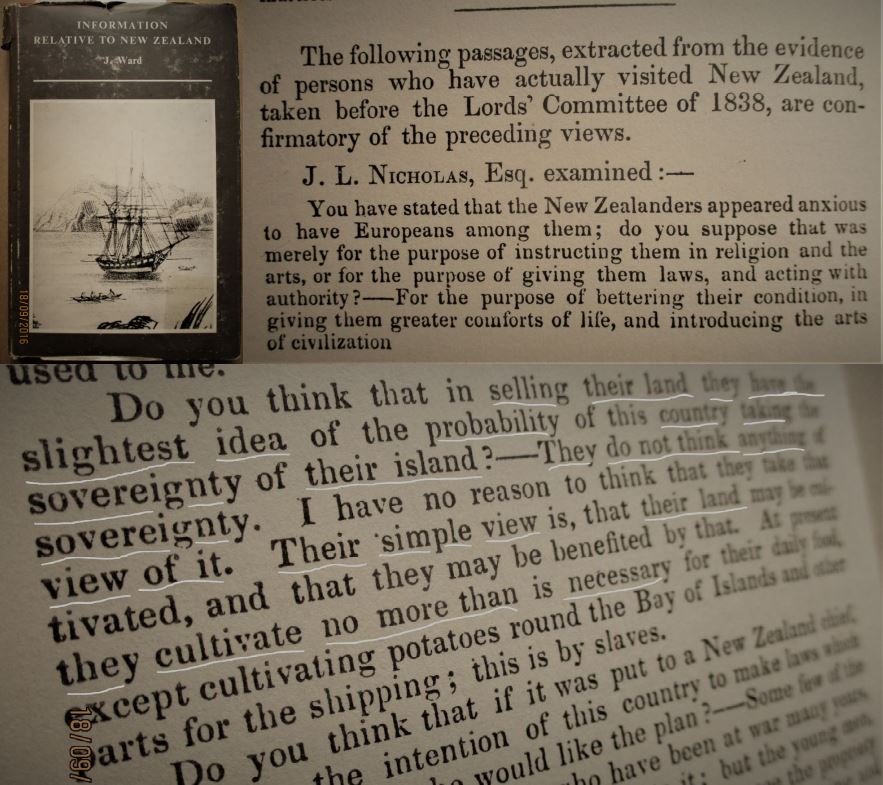
The same day, the second clanker moment came Chief Te Ruki Kawiti of Ngati Hine, who told Hobson to leave as he expressed his apprehension that Māori would be cast as an oppressed people through slavery, jail or warfare. In this way, Kawiti’s clanker touched upon the matter of sovereignty. In effect, Kawiti had thrown a wrench at the gears of a metaphorical Treaty Parchment Contraption Engine.
A clanker moment of a third kind happened on February 6th when French Catholic Mission, Bishop Jean Baptiste Pompallier, interjected to ask Royal Navy Captain William Hobson — who was appointed British Consul to gain paper sovereignty — if there would be tolerance for diverse religious teachings under the treaty.
The fourth clanker occurred as Chief Hōne Heke Pōkai got up to sign on February 6th at Waitangi. Church Missionary Society (CMS) printer William Colenso interrupted to ask Captain Hobson if the “Native chiefs” understood the treaty.
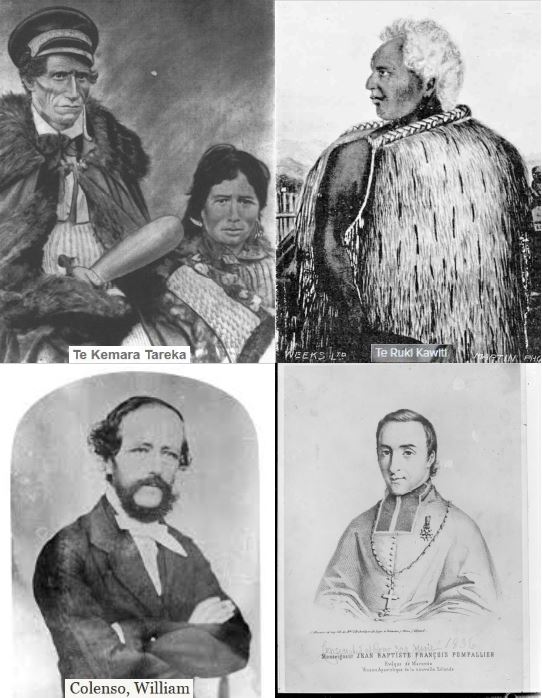
Each of these clankers could have derailed what was, in effect, a track-laying vehicle for the British Masonic Empire to forge a colony out of what had been construed in 1835 as an independent Māori state comprised of numerous hapū and iwi.
When the four clanker moments arose, the Treaty Cliqué theatre performed off-script as they were compelled to adopt improvised acting to mask over critical context that was either left unspoken, untranslated or unilluminated — lest the ‘Treaty Theater Train’ became derailed amid the likely hissing of steam.
If there had been defections by participants within the Treaty Cliqué during these clanker moments, the elements of the Discovery Doctrine would have been exposed and its use as a track-laying vehicle ruined, without the chiefs needing to know about the doctrine itself.
And if a full-blown mutiny at Waitangi had revealed essential facts of context, it is likely that a total walk out by the chiefs would have ensued, and word would have spread of the hissing steam from inside the Treaty Tent, which figuratively acted as a make-shift Treaty Train Station on Busby’s swindled lawn, which for two days in early February 1840, was the site where the Treaty Train Engine and its Imperial Carriages metaphorically ‘parked’.
That steam would have hissed as much from the ‘Treaty Parchment Contraption Engine’ that metaphorically produced the deceptive language translations, as from the other representatives and witnesses of the four empires that intersected inside the Treaty Tent, as well as from the chiefs and chieftainesses.
According to the English text version of the Third Article, the Māori signers fully understood the Treaty. Yet in the Māori text of Article Three, the Queen contracted to look after the Māori people and was afforded a kaitiaki role of guardian, in recognition of the governorship role accorded to her. Meanwhile, in the English text, ‘the Natives of New Zealand’ were given “all the rights and privileges of British subjects”, as consideration for their chiefs signing away sovereignty.

The ‘Colonial Law Track’ – From Captain Cook to Captain Hobson
Whereas, the Colonial Law Track — comprised of the proclamations, new commissions, swearing-in officials, letters patent, legislation, gazetted notices and a royal charter — was the primary route through which the completion of the annexed title claimed by Freemason Bro. Captain James Cook actually occurred.
In other words, the ‘Endeavour Voyage’ in 1769-1770 was New Zealand’s first travelling theatrical production, while the Waitangi Treaty Theatre was the second and smaller budget show — staged to distract, divide and defeat.
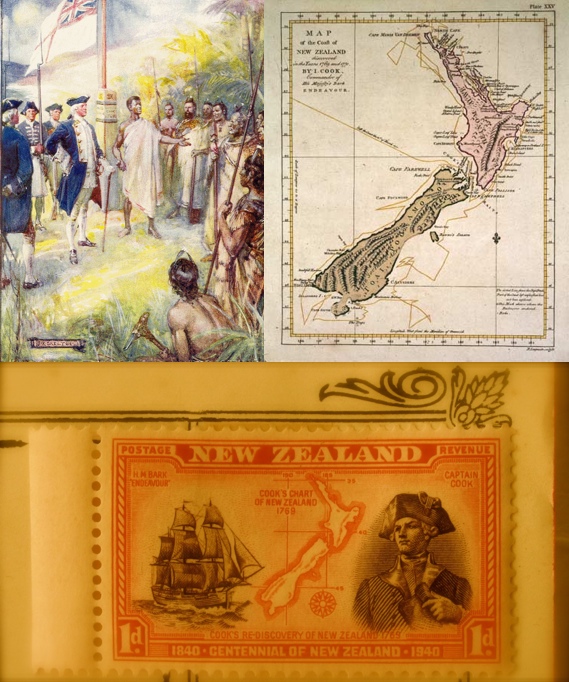
The key pieces of Colonial Law Track laid parallel to the Treaty Theatre Track to gain British paper sovereignty were:
(1) a Letters Patent of Boundary Extensions activated by Royal Prerogative Powers, dated June 15th 1839, which expanded the jurisdictional boundary of New South Wales to include all of New Zealand;
(2) a Letters Patent of Amended Commission to Governor George Gipps making him Governor of New Zealand, a new dependent colony of New South Wales, signed by Her Majesty’s Command bearing Lord Normanby’s name on July 30th 1839;
(3) Governor George Gipp’s Proclamation of January 5th 1840 establishing N.Z. Customs;
(4) Gipp’s three Proclamations of January 14th 1840 notifying the extension of the boundaries of New South Wales to include New Zealand, Captain Hobson’s Commission as Lieutenant-Governor and a notice that land Sales after January 5 1840 would not be valid and land sales before that date would be subject to official scrutiny;
(5) Captain Hobson’s Proclamation of January 30th 1840 declaring himself as Lieutenant-Governor in an Anglican chapel, Christ Church, in Kororāreka before 300 settlers and 100 Māori;
(6) Lieutenant-Governor Hobson’s Proclamation of May 21 1840 claiming sovereignty over the North Island on the basis of cession by Treaty and over the South Island on the grounds of Cook’s Discovery;
(7) the New South Wales Continuance Act (or the “New Zealand Act of 1840”) with a separation empowering clause to sever New Zealand from its status as a dependency of New South Wales without expressly naming New Zealand, was passed in the NSW Legislature on 16 June 1840 as 3 Vic No 28;
(8) in Westminster, London, the New South Wales Continuance Act was passed on 7 August 1840, with a severance empowering clause to erect a separate Colony of out of those islands considered as Dependencies of New South Wales;
(9) Ratification of Hobson’s sovereignty Proclamation of May 21st 1840 in the London Gazette on October 2 1840, after it was received in London on September 28 1840;
(10) the Royal Charter for Severance (or Charter of 1840), authorized by Queen Victoria with the Royal Privy Seal and dated 16th November 1840 establishing New Zealand as a separate colony upon receipt of the Long Roll of Parchment on November 10;
(11) the Governor’s Commission of 24 November 1840;
(12) the Royal Instructions of December 5th 1840; and
(13) Hobson’s oath as Governor and Commander-in-Chief on May 3rd 1841, which was notification that New Zealand was no longer a dependency of New South Wales.
The Letters Patent device to erect a separate colony was timed to occur after the Treaty parchment arrived in London on November 10 1840 — to make it appear the Treaty was the means by which sovereignty was acquired. The receipt of the signed treaty was the signal for the erection of a separate Colony, since Queen Victoria’s Letters Patent of Severance and the Royal Charter of New Zealand are dated six days later — as Foden noted in 1938.
Therefore, these moves were the legal mechanics of the heist by paper, pen and props over New Zealand that were made prior to, during and after the signings of the 1840 Waitangi Treaty. These colonial law devices were the real means by which the British Crown laid claim to paper sovereignty, and perfected the incomplete ‘First Discovery’ title claimed by Freemason Captain Bro. Cook for the British Masonic Empire.
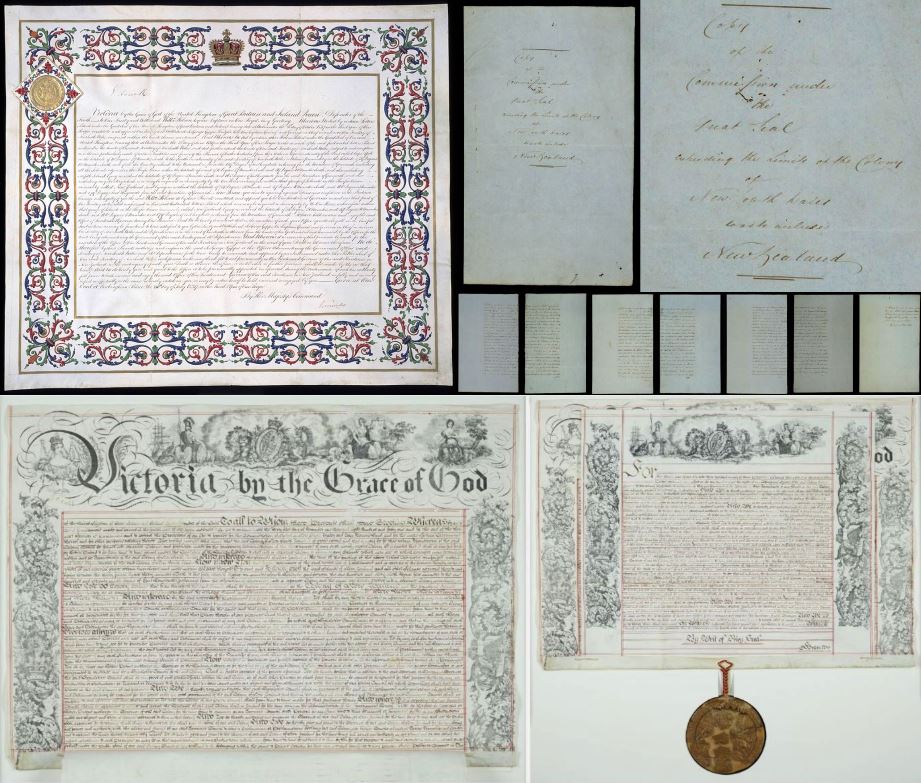
The ruse to gain the appearance of the chiefs ceding sovereignty to Her Majesty at Waitangi on February 6th 1840, can be seen by the date at which New South Wales Governor George Gipps became Governor of New Zealand: 30 January 1840.
And also Governor George Gipp’s Proclamation of January 5th 1840 establishing N.Z. Customs, one full month prior to the first signings of the Treaty at Waitangi.
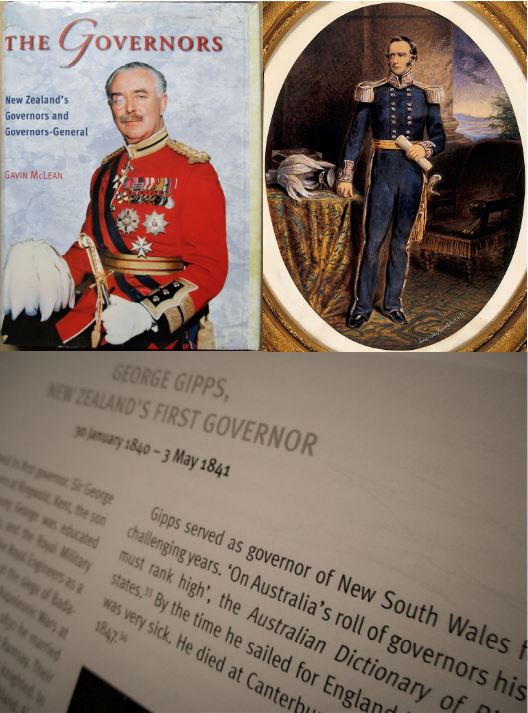
Government historian Richard S. Hill stated in his history of policing in New Zealand, that ‘cession by treaty’ was a pretense to neutralize anticipated Māori opposition, stonewall representative civil government for settlers, and to deconstruct the façade of an ‘independent state’, designed by the British.
Like Foden, Hill found New Zealand joined the British Empire on the basis of settlement by the continuous occupation of 2000 Britons, when it was annexed by the Letters Patent of Boundary Extension on June 15th 1839. Settlement, once formalized by a European Power, became an unchallengeable title, Hill stated in volume one of Policing the Colonial Frontier: The Theory and Practice of Coercive Social and Racial Control in New Zealand, 1767-1867, which was published in 1986 for the Department of Internal Affairs.
With stinging clarity, Hill continued:
“The pretense of acquisition by treaty cession was a device both to defuse Maori resistance by appearing to sanction their retention of ‘the substance of the land’, and to avoid providing the settlers with the representative institutions to which a ‘colony of settlement’ was entitled. In addition, it was a theoretical deconstruction of the edifice of ‘indigenous sovereignty’ earlier erected by the British for their own purposes. Traditional historians, puzzled by the apparently ‘anomalous constitutional position’ of Hobson announcing himself as Lieutenant-Governor immediately upon landing on New Zealand soil on 30 January, before even the initial ‘Treaty’ signatures were procured, took Waitangi at its face value.”
In other words, the 1835 ‘Declaration of Independence’ was regarded as an edifice that construed New Zealand was an independent state, and that could be deemed null and void with the ‘Treaty Chiefs’ appearing to wittingly sign away their ‘indigenous sovereignty’ in 1840. Hill stated that the Colonial Office bestowed Hobson the mission to move with speed to procure full sovereignty with the theatre of native consent by treaty cession, because “immediate and total acquisition had already been decided upon and implemented”.
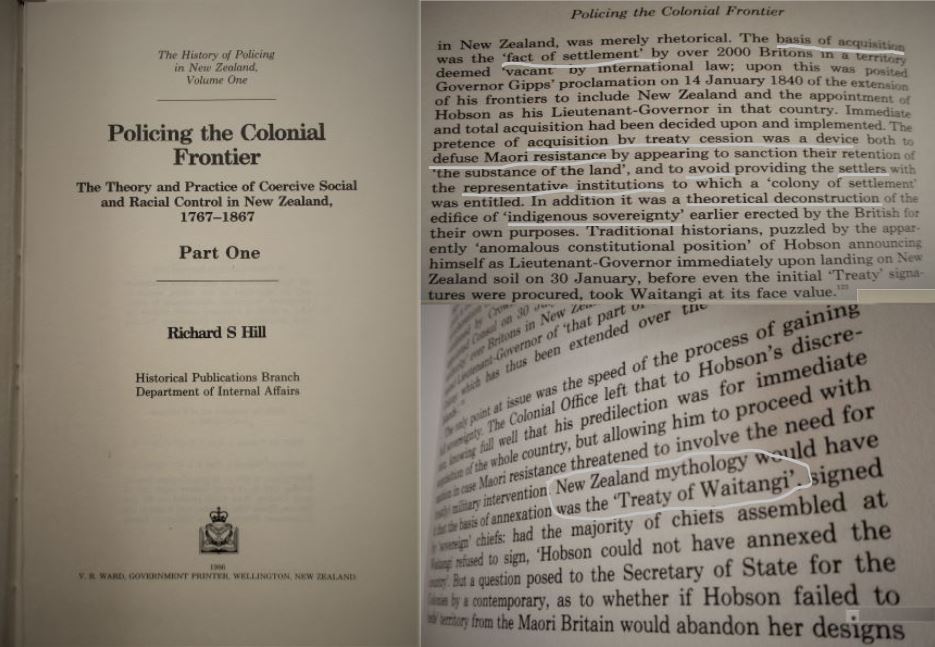
Prior to the passage of the New South Wales Continuance Act in the NSW Legislature on 16 June 1840 — which severed New Zealand as a dependency of New South Wales — Governor Gipps changed the preamble of this bill. Gipps modified the language, from claiming that Queen Victoria had acquired the Sovereignty over parts of New Zealand, to annexing New Zealand to the jurisdiction of New South Wales. It would seem Governor Gipps realised that if the New South Wales Continuance Act appeared to attribute Queen Victoria’s sovereignty authority over parts of New Zealand to the collection of Māori signatures, such a move would cause legal problems.
If Gipps enacted the Treaty as the basis for acquiring sovereignty over Māori, he would have essentially ratified the Treaty in Statute Law, which would open up the legislature of New South Wales, New Zealand and the United Kingdom to scrutiny of the Waitangi Treaty, and direct challenges in case law, which would likely cause great displeasure to Her Majesty. If Gipps had made the error of enacting the 1840 Waitangi Treaty as the basis for acquiring sovereignty, he would have soon run into trouble to argue for the British Crowns pre-emption rights as a legal mechanism for extinguishing native title through Crown purchases.
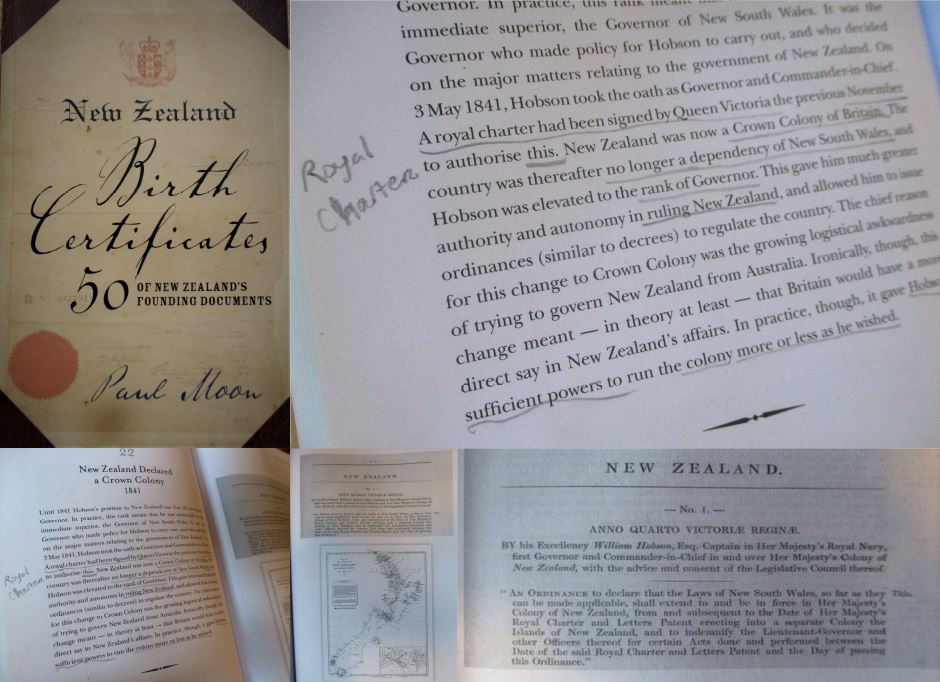
When it came time for the Monarch to, essentially, ratify the paper heist, the same politically hygienic rhetoric that had been copied from Normanby instructions into the preamble of the Treaty, was subsequently plagiarized when it was also copied into the Queen’s Royal Charter, which erected New Zealand as a separate colony on November 16th 1840.
The Charter of New Zealand, as it is also known, empowered the governor to grant lands — deemed by European eyes to be waste or uncleared lands — to settlers and their corporate bodies, to establish towns, counties and public buildings and other infrastructure.
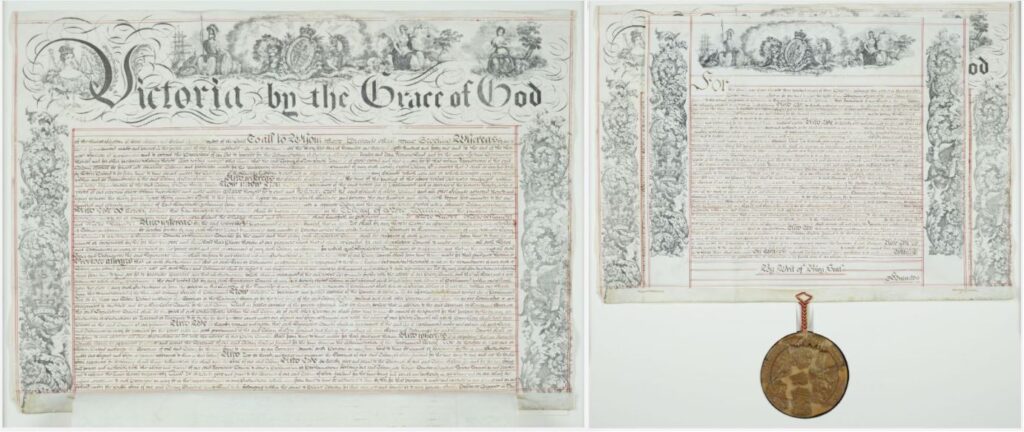
Once Queen Victoria’s Letter Patent of Severance and the Royal Charter of New Zealand were ratified with the Privy Seal of the United Kingdom in mid-November 1840, the British Crown’s title became unchallengeable by British subjects, under English Constitutional Law, and was recognized by other nations under International Law.
The usurpation that occurred in 1839 and 1840 was a usurp d’état rather than a coup d’état, which is a sudden violent seizure of power of a state. The seizure of power was usurpation since a revolution is the upending of a social order by people already living in the society. This re-framing of what occurred in 1839 and 1840 does not mean a revolutionary dynamic was absent.
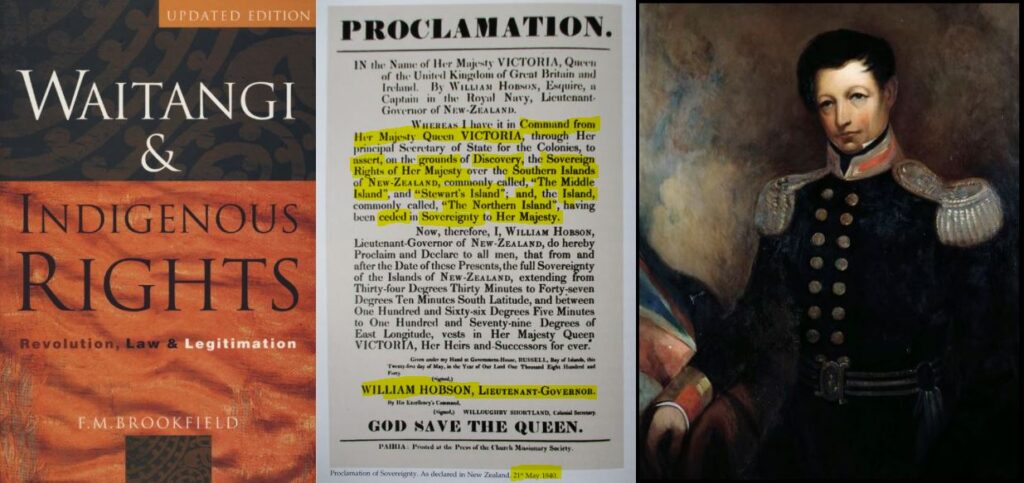
The trickery was designed to eventually lead to structural entrapment to justify a war of sovereignty by construing any Māori who fought back, or whom materially assisted the warfighters, as being in rebellion, since British Freemasons and Protestant settlers would maintain supremacy over the public and private systems of propaganda in Britain, New Zealand and Australia.
That structural entrapment would take the form of provoking Māori into reacting to incursions on their sovereignty, lands and customs, and would be the catalyst for the Northern War of 1845-46 and the New Zealand Masonic Revolutionary War of 1860-1872.
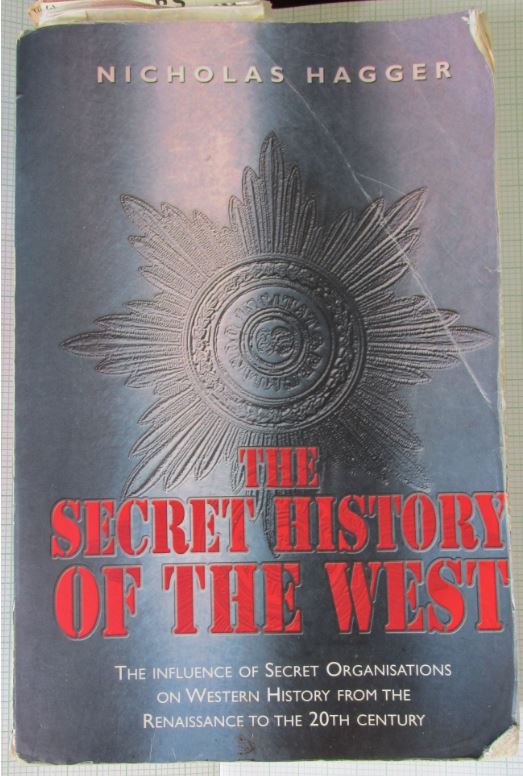
In his epic 2005 study, The Secret History of the West, English historian Nicholas Hagger modelled the patterns of revolutions, how subversive secret Masonic societies plotted them and the reasons for the subterfuge. Drawing upon 550 years of revolutions, Hagger shows that all revolutions have four distinct stages with four archetypal characters. An Occult Idealist expresses a heretical vision, which is given an intellectual expression by an Intellectual Interpreter. A Political Actor takes this blueprint into the political realm, where it is corrupted by the ruling regime, and led by a Consolidator, those secret groups most invested in the occult vision plot physical repression to realize their utopia.
In other words, the violent conflict that became the New Zealand Masonic Revolutionary War of 1860-1872 was the consolidation of stage of a revolutionary dynamic set in motion long before the Waitangi théâtre usurp d’état. As Ranginui Walker correctly observed in Struggle Without End, Governor George Grey was recalled for a second governorship to consolidate the colony at a time when the First Taranaki War of 1860-1861 had faltered for the colonists. Walker, however, was unaware of the hidden Masonic layer of the Christian British Empire that underpinned the New Zealand Masonic Revolutionary War of 1860-72.
Therefore, the Waitangi Treaty Theatre was staged to distract, divide and defeat Māori whom could be predicted to miss the legal mechanics laid, that comprised the Colonial Law Track.
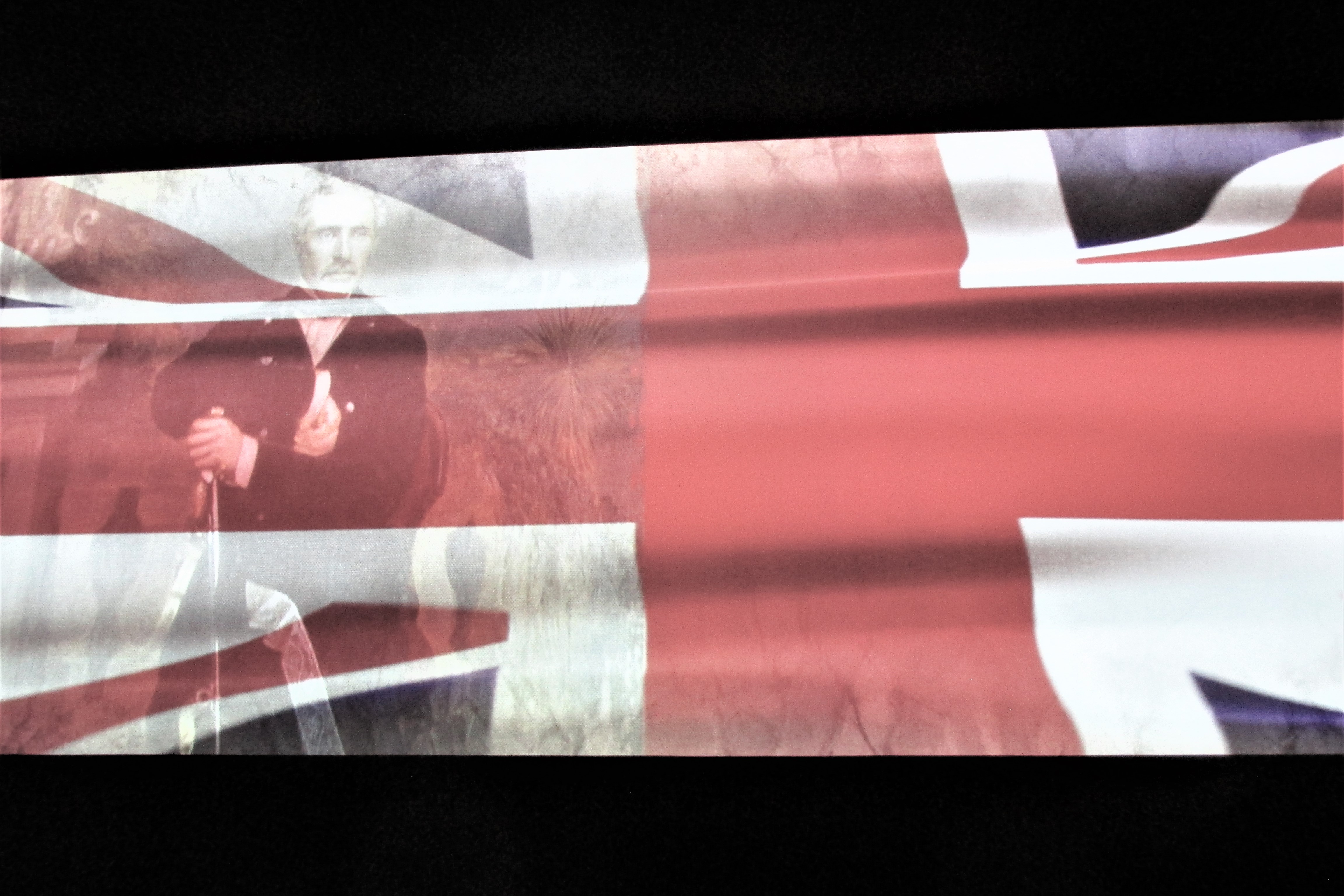
Ironically, this Colonial Law Track was the real trunk line through which the completion of the annexed title claimed by Freemason Bro. Captain James Cook actually occurred. This unsanitized truth has remained hidden, first by statecraft subterfuge that established the mythology of cession of sovereignty by treaty, then by ideological dogma created out of this cunning simulation of reality, and all the while, by the maintenance of a structure of contrived ignorance set in motion by the Treaty Cliqué.
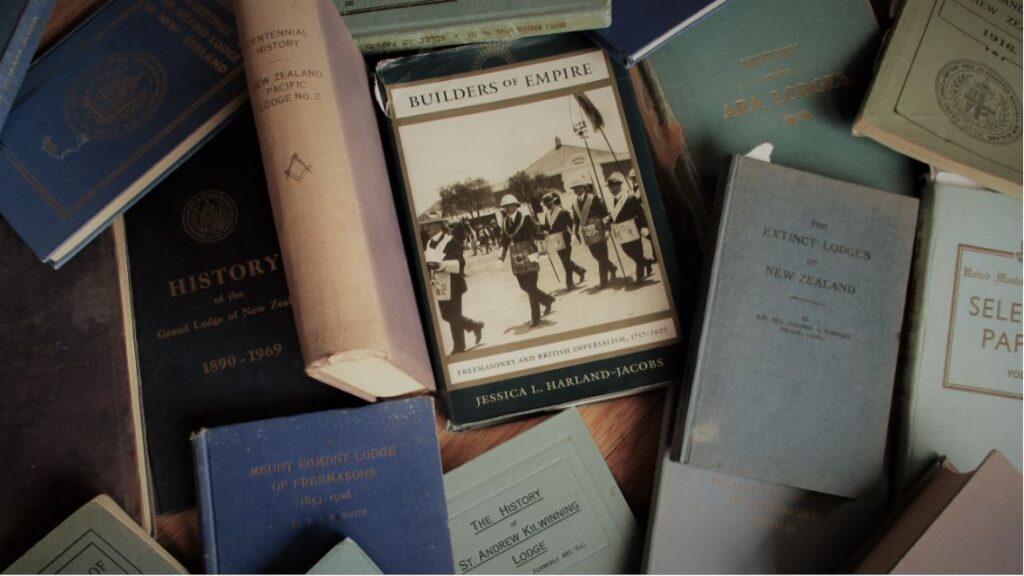
Freemason Captain Bro. Cook had expressed the Masonic occult vision that New Zealand was strategically important due to its geographical location and resources 70 years prior.
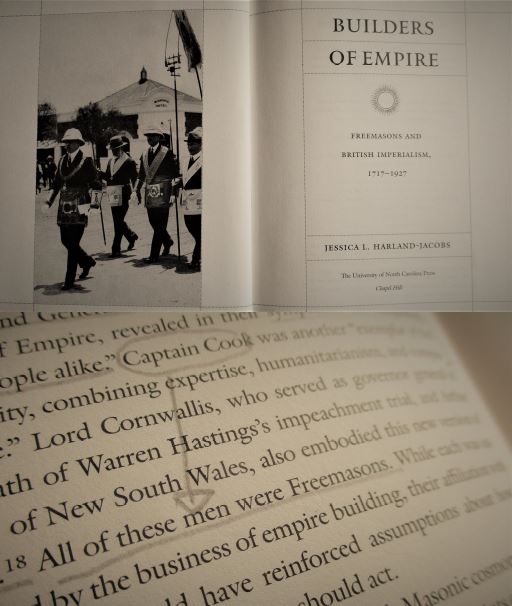
Therefore, an internal revolutionary logic, dynamism and cast of conspiratorial characters underpinned the mission to treat by trickery with the ‘Aborignees’ of New Zealand.
The travelling ‘Treaty Theatre Company’ served as a Deus Ex Machina plot device that unexpectedly resolved an ‘impossible impassé’ and a narrative conflict regarding Britain’s waning geopolitically dominant position.
Derived from Greek and Roman theater, a Deus Ex Machina (or god from the machine) is a plot device that unexpectedly resolves a deadlocked conflict, by the sudden appearance of an implausible character, object, event, power or action.
The received sanitized story is that Britain’s ‘hand was forced’ by the second New Zealand Company and other land swindling syndicates making extensive claims to soil, over which Britain had no jurisdiction, to prevent ‘evil’ upon the Native New Zealanders, as Paul Moon and Peter Biggs argued in their 2004 book, The Treaty and its Times: The Illustrated History.
In 1837, convicted heiress abductor Edward Gibbon Wakefield had published his book, The British Colonization of New Zealand, in which he gave intellectual shape to Lord Durham’s vision to establish settlements among a ‘savage people’ to lead ‘the natives’ in higher civilization through advanced religion, language, laws and social norms rather than a policy of extermination, as Anne Salmond noted in her 2017 book, Tears of Rangi: Experiments Across Worlds. The same year, 1837, Edward Gibbon Wakefield co-founded the second New Zealand Company, as a settlement-establishing enterprise for British peoples to emmigrate.
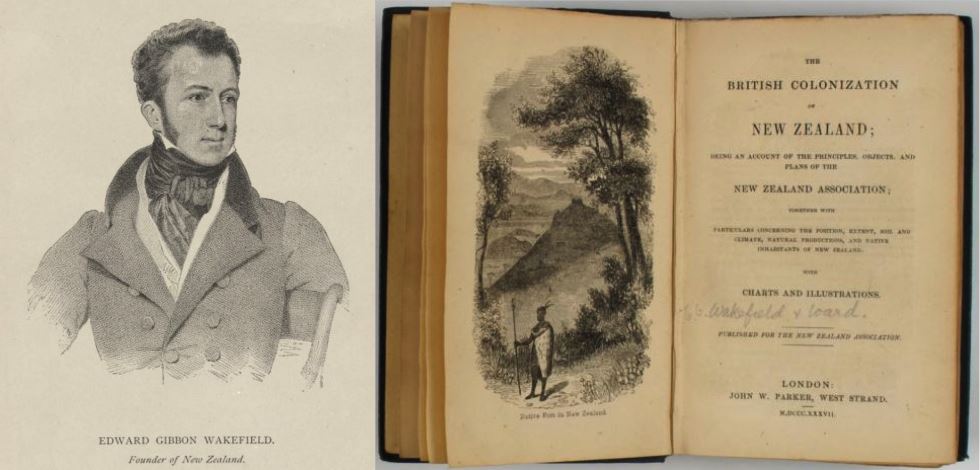
Getting legislation passed in the British Parliament would have attracted the attention of the French, the Americans and the Vatican, thereby risking the enterprise to gain a far-flung colony on the cheap.
If the British Masonic Empire failed to complete the sovereign title claim to New Zealand, that failure of action would further threaten the transmarine empire’s standing. New Zealand was regarded as geopolitically strategic in both times of peace and war, due to its geographic location in the South Pacific Ocean.
If however, the British Masonic Empire could win paper sovereignty with innovative theater, its reputation among the pirate sovereigns of Europe and North America — as brazen swindlers would be enhanced. Because — the pirate sovereigns of the ‘cannon powers’ would marvel that a ‘cession’ of territory was construed to have occurred without firing a shot.
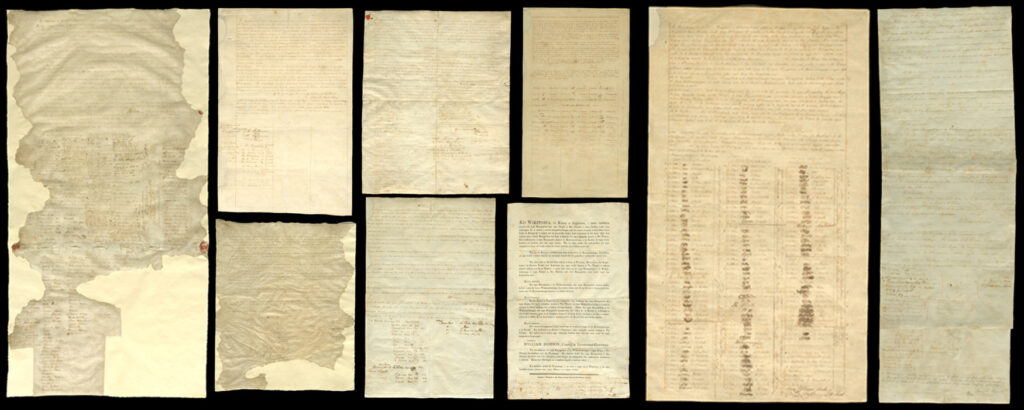
The urgency to trick Māori into appearing to cede sovereignty in a compressed time was not only compelled by the ‘need’ to forestall the Second New Zealand Company’s foray into unregulated private land swindling, emigration and self-government, as well as possible moves by the rival French Empire to acquire sovereignty, given the presence of Bishop Pompallier.
Those ‘needs’ for the Treaty Cliqué in London to instigate moves to acquire sovereignty were the triggers for the endgame stage in 1839 of the Treaty Track that began to be laid in 1831 to 1833, from the time of James Busby’s lobbying and appointment as Britain’s first official to reside in New Zealand for the express purpose to make treaties with Māori.
Therefore, rather than the Waitangi Treaty affair being officially re-told as simply a series of mistakes, thoughtlessness and unfortunate callous individual agendas culminating in ‘translation errors’, such positively spun explanations disingenuously continue the clichéd tradition of a well-intended British cock-up. The endgame stage of the Treaty Track was actually the activation of long-game to takeover New Zealand by one means or another.
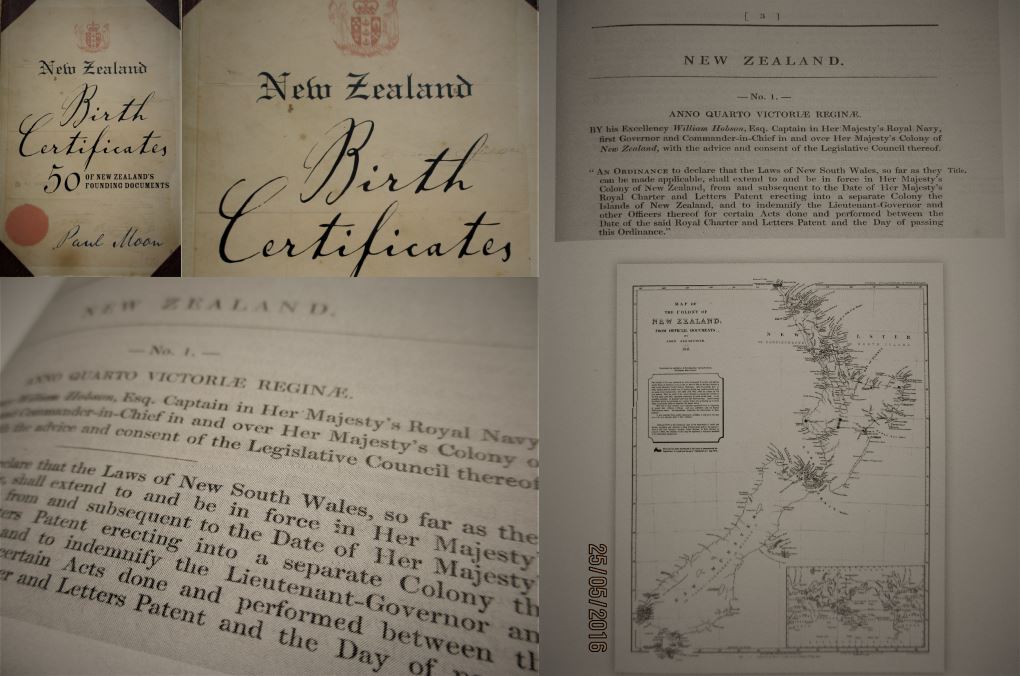
As Norman Arthur Foden pointed out in his 1938 work, The Constitutional Development of New Zealand in the First Decade (1839-1849), treaties between a European Power and an indigenous people could only make it through the courtroom hoop, if a judiciary could be convinced that the particular circumstances were justified. The Preamble in the 1840 Waitangi Treaty, which spoke to circumstances such as averting evil consequences of unregulated emigration, were part of the subterfuge to legitimize the theatrics. To a learned bench of judges, it would have been rather obvious that an exquisite piece of theatre had been deployed with props of paper, pens and presents to persuade Māori to happily, generously and unreservedly give away their sovereignty forever to a Germanic Queen who had been enthroned in Westminster City just three years prior, and whom they had never met.
A learned bench of judges would also surely have seen the Waitangi Treaty Tour left little time to consult, reflect or propose counter-solutions, among a people unaccustomed with the entanglements of European laws, written words and the acceptance of presents. For the most part, consultation, let alone negotiation with rangatira — who lived among the heavily feathered and highly roastable moa in the interiors — was either forestalled or forgone, because it would have been counter to the Treaty Theatre’s linchpin strategy: the weaponization of time.
In Policing the Colonial Frontier, Richard S. Hill stated that the Colonial Office bestowed Hobson the mission to move with speed to procure full sovereignty with the theatre of native consent by treaty cession, because “immediate and total acquisition had already been decided upon and implemented”.
This finding concurs with Foden’s thesis. Foden, who was a barrister in the Supreme Court of New Zealand, found at the time of the British takeover of New Zealand, there were three classes of colonies designated according to their mode of origin: by settlement (or occupation), by conquest and by cession.
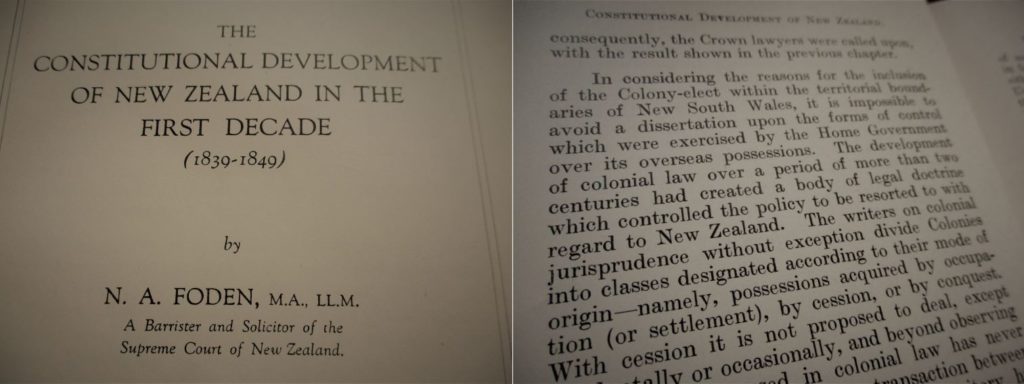
Even without being aware that the Treaty spun on the innovative fulcrum of deceptive translation differences, the Treaty would have been deemed null and void in English courts. This ‘dead in the water’ result for any treaty claiming full sovereignty over an entire indigenous people, is precisely why new Colonial Law Track was laid with Queen Victoria’s authorization of June 15th 1839.
That Colonial Law Track intersected at Waitangi in 1840 with the Treaty Theater Track that Busby envisaged in 1831, and had advanced with his appointment as the British Masonic Empire’s first official stationed in New Zealand. Even though Busby wouldn’t have known its eventual timetable and journey, the commissioning of Busby in 1832 for the job of British Resident demonstrates the British State’s dexterity, or nibble fleet-footedness, to recombine cunning ideas to improvise or script new plays from its Imperial Bag of Tricks.
The innovation of the two trick-laden language versions of the 1840 Waitangi Treaty to gain sovereignty over an entire ‘nation’ meant that, in essence, the parchments were spun on a fulcrum that pivoted upon deceptively-crafted translation differences in the texts. By this swindle, a territory the size of Great Britain was gained on the cheap with presents, persuasion and unseemly post-haste. Had the Treaty Cliqué fully disclosed to Māori that they sought to drastically diminish their mana, accumulate their hapū political structures into tribal units for later de-tribalization and transfer their tino rangatiratanga to Queen Victoria, the Treaty Cliqué’s heads would likely have been skewered on sticks at someplace and sometime before autumn of 1840. Therefore, the fulcrum of deceptive translation differences in the 1840 Waitangi Treaty texts worked to hide the omissions of intent, imperial context, and history.
In short, the 1840 Waitangi Treaty Cliqué pulled off a brazen theater usurp d’état because the English version construed a willing transference of full sovereign powers to Queen Victoria and her heirs, forever. This English version would be used as the proof of a legitimate acquisition of sovereignty, since all inconvenient context was excluded.
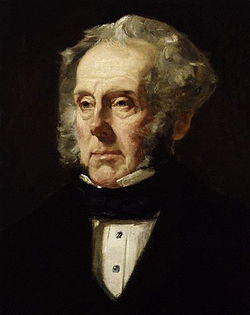
Amid the complications of running the British Masonic Empire, the imperial ‘need’ to acquire sovereignty over New Zealand also occurred at a time when the high priest of British Freemasonry, Lord Palmerston, was planning the first of two wars with the civilization that invented the very medium upon which the fraudulent bi-lingual Treaty copies were written: China.
The Royal Naval Captain had envisaged a ‘factories scheme’ for New Zealand that described a system of naval-protected trading posts owned by the British Crown, following a treaty. Captain Hobson’s 1837 plan envisaged the factory enclaves would be controlled by a British Governor, whom would have authority over Pākehā and Māori. That factory trading system had been copied from the Portuguese to gain a foothold in India in 1668, first on the Island of Bombay, its port and its harbour. In effect, this scheme meant the Secretary of State for War and the Colonies, Lord Normanby, and Secretary of State for Foreign Affairs, Lord Bro. Palmerston, well-knew that Captain Hobson’s Factory Scheme was based upon the factory trading system used by the British East India Company.
According to historian Anthony Chaitkin found in his epic study — Treason in America — which tracked the machinations of a secret network of British-Swiss-Dutch-Venetian plotters from the American Revolution to World War II, Lord Palmerston’s Broadlands family estate was the headquarters for the British Masonic Empire’s ‘black operations’ to subvert rival powers, competing coalitions and indigenous peoples. Thus, when Lords Normanby and Bro. Palmerston tasked Hobson in 1839 to treat with the ‘Native Chiefs’ for their willing and conscious cession of sovereignty and informed consent to grant monopoly rights to extinguish native land estates, they were sending in 1839 no ordinary Royal Naval Captain.
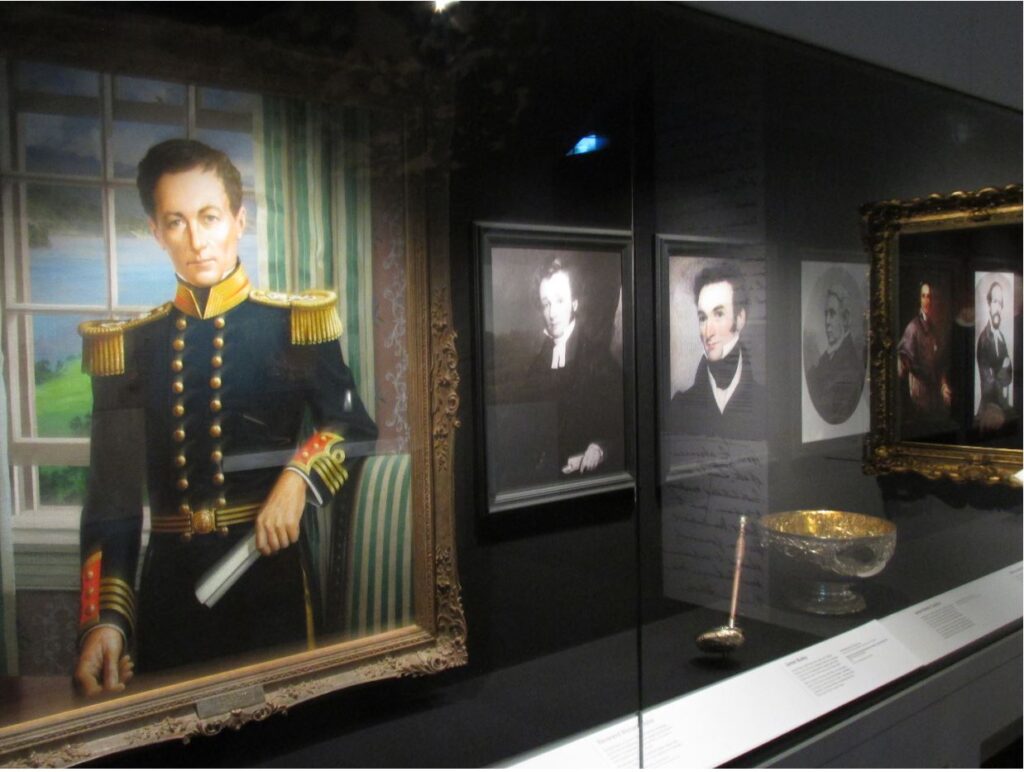
Because Lord Palmerston, was simultaneously ‘lining up his ducks’ to trigger the First Opium War as part of a long-game to consolidate footholds in China, no troops or military could not be spared to expand the maritime empire to include New Zealand at that time
This lack of military support made Hobson nervous about his mission to persuade the New Zealanders — as Māori were frequently designated in pre-colonial era.
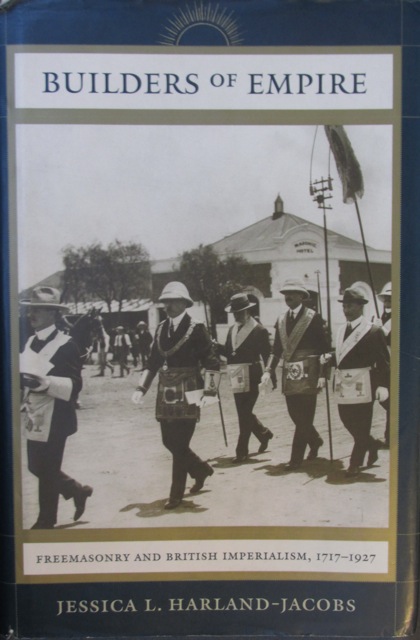
Queen Victoria’s historic travelling theatre production is perhaps best viewed as a Masonic imperialist expression of applied ‘Orientialism’, as described by Edward Said more generally in his seminal 1979 book, Orientalism. Said observed that events in the Orient of the Near, Middle and Far East, North Africa and the ‘New World’ were repeatedly turned into theatre to save the events from oblivion by ‘Orientalists’, or Europeans aiding the categorizing, Christianizing and colonizing projects. The modus operandi of the Orientalist, was to consult ‘the natives’ for a text whose usefulness was not to indigenous people; a practice that stretched back to at least the second century B.C.
It turns out, the primary secret mechanism by which the British Empire spread throughout the ‘New World’ was through the subversive secret society of Freemasonry. In turn, Freemasonry was spread mostly through the military regiments, including the navy, as Jessica Harlands-Jacobs stated in her book, Builders of Empire: Freemasonry and British Imperialism, 1717-1927.
At its core, the Masonic Lodge System served the ideological function of activation to unite against a common enemy with a subversive private parallel political, commercial, martial and cultural structure that spread from the ‘Old World’ to operate in new ‘Masonic jurisdictions’ of the ‘New World’ for its re-ordering — either by Masonic Capitalism, Masonic Socialism, or Masonic Communism. This meant Freemasonry became a key conduit for the marketing ideas of European superiority among an international network of loyal men whom forged the capacity to act as a subversive confederacy to undermine indigenous nations for their subjugation, de-tribalization or extermination – depending on the circumstances.
Therefore, the travelling theatre production was a Masonic imperialist expression of applied ‘Orientialism’, which was masked with a humanitarian mission cover-story to formalize the mechanisms wherein New Zealand would be coded, chronicled and conquered under a British banner.
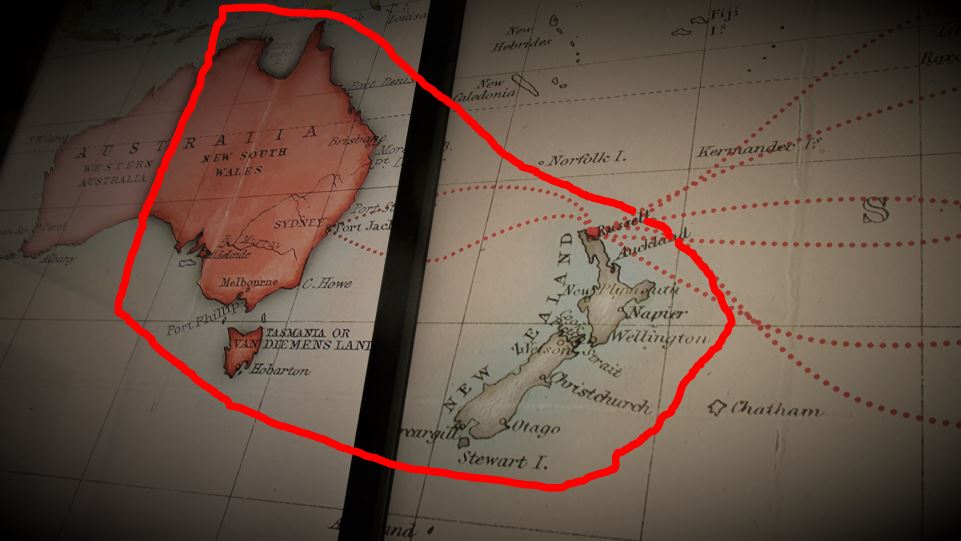
Thus, while the Treaty Cliqué raced toward the endgame to capture new political space via a sovereignty payload, they acted like a travelling theater company to weaponize the one physical dimension they could control though emotional hijacking, Orientalist swagger and novelty: time.

Conclusions to Deep History of Waitangi: The Queen Victoria Connection
The phenomenology in the three major categories outlined above are the ‘physical parts’ for the anatomy of an epic power crime. Those three major categories — the Discovery Doctrine deployed in a two-track route, the Treaty Theater spinning on a fulcrum of language translation differences, and the clanker moments — together reveal the witting deception required to keep the Imperial Elephant in the Treaty Tent invisible to the rangatira, the cheiftainesses and hapū gathered.
The Treaty Theatre pivoted upon a fulcrum of deceptive translation differences in the 1840 Waitangi Treaty texts that hid the deceptive power crime to win native signatures and paper sovereignty by weaponizing the physical dimension of time.
The incontrovertible fact is that the Waitangi Treaty Signing Rituals were a hostile stage production performed to take over the Māori nations, or a théâtre usurp d’état. The object itself was a literary device designed to distract from the Colonial Law Track upon which the tenuous claim to sovereign title was first acquired by boundary extension with a Letters Patent and subsequently ratified with a Royal Charter to erect a colony.
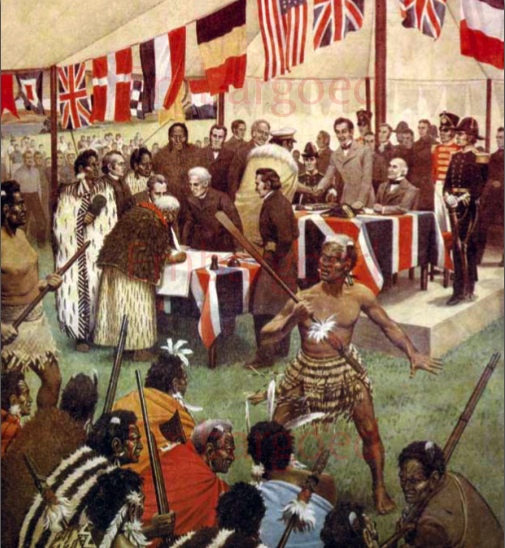
This finding proves the 1840 compact was a red herring mechanism to sponsor logically fallacious arguments to hook enough Māori, and — subsequently divide and defeat the tribal race.
The intention was to lead its audience to a false conclusion, whom would not comprehend the Waitangi Treaty Theater was, in effect, a simulation produced to create a copy of reality intended to eventually forge subject race pacification during and after the consolidation stage of what was, in fact, the New Zealand Masonic Revolution.
Therefore, the Waitangi Treaty Tour as a theatrical production, or théâtre usurp d’état, was designed with a red herring device to distract from the Colonial Law Track — in part to save face for the Monarch because such annexations of territory from indigenous races of the ‘New World’ drew rebuke. By achieving the appearance of sovereignty cession to the Monarch, with the English language version, Queen Victoria and her hereditary heirs, would gain a geographically and strategically valuable territory equivalent in size to Great Britain — forever.
The red herring logical fallacies within and between the 1840 Waitangi Treaty bought time while the revolutionary possession was peacefully established, with witting plotting that eventually ‘the natives’ could be construed to be in ‘rebellion’ when they ‘reneged’ on the Treaty ‘agreement’.
No one bothered to explain to rangatira why a Crown monopoly over land sales was really being secured. By passing such land transactions through the Crown, native titles could be extinguished forever more rapidly, in accordance with the Doctrine of Discovery element of Preemption-European Title.
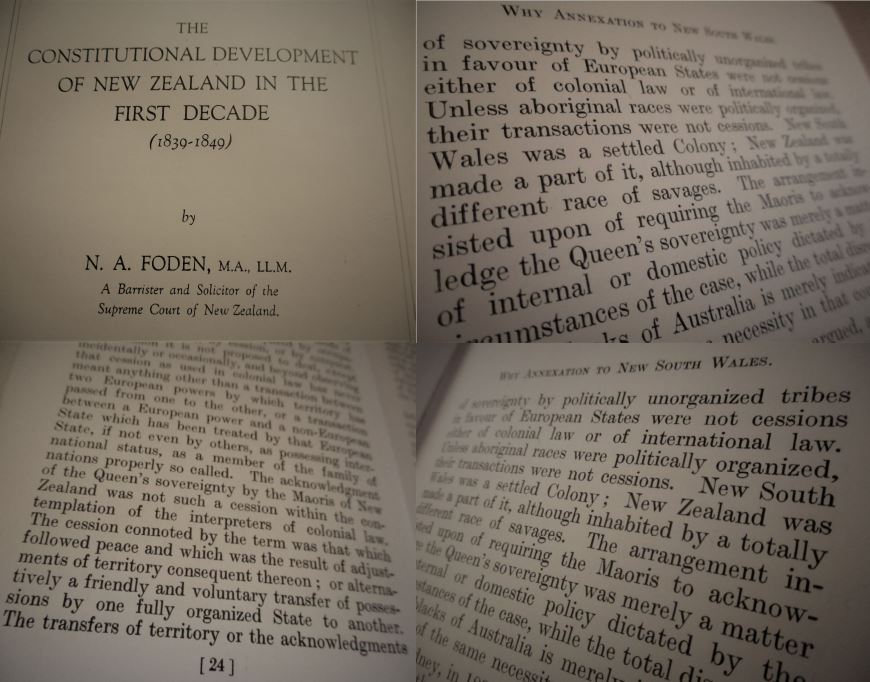
By setting in train structures, mechanisms and strategies to diminish the size of the Native Estate, which was the substance of Māori independence, because it was based on land tenure — this substantive sovereignty of the soil dwindled too. Therefore, the development of New Zealand would be retarded until Māori control over territories was upended, since such indigenous economic dynamism could not be tolerated.
In this way, the Treaty signing rituals were a major visible step of a ‘long-game’ that would climax with casting unwitting Māori into wedges of war, where struggles over soil would be fought to transform paper sovereignty into substantive sovereignty.
To be more precise, the Treaty of Waitangi was a manifestation of the Doctrine of Discovery element of Preemption/European Title which was the crucial mechanism for the Crown to construe conscious consent to the British Crown for a monopoly over land purchases and superior land titles that could extinguish native title.
In the final analysis, the British Masonic Empire acquired the islands of Aotearoa New Zealand on the basis of occupation and wrested paper sovereignty by usurpation.
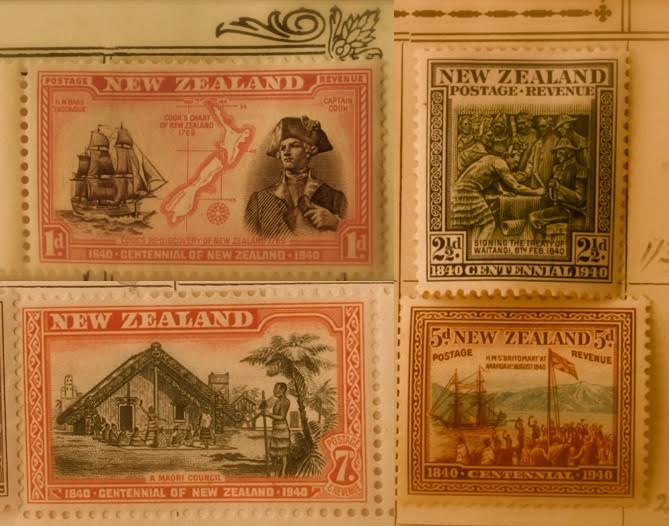
Thus, the New Zealand Masonic Revolutionary War of 1860-1872 was the consolidation stage of revolution set in motion on June 15 1839 with the Letters Patent of Boundary Extension, which established New Zealand as a dependent colony by acquisition mode of occupation (or settlement), and ratified on November 16 1840 by Letters Patent of Severance and Royal Charter, which erected New Zealand as a separate colony, by acquisition mode of usurpation.
Therefore, the machinations underpinning colonial state formation over the islands of New Zealand is evident from the memoranda, letters patent, commissions, proclamations, legislative acts and a Royal Charter as artifacts of state manœuvres to forge new Colonial Law Track consistent with English Constitutional Law.
Meanwhile, a regime of sematic algebra advanced in a nationwide theatrical production company that would report back a tale of cession of sovereignty over an entire indigenous people. In this conjuring of a colony, “cession” no longer meant territory passing between belligerent powers following cessation of armed conflict because the only shots fired was to mark the arrival of Captain Hobson, and his subsequent pomp to claim cession.
By these colonial law instruments, paper sovereignty was wrested by usurpation, for the expansionist second British Masonic Empire (1815-1918).
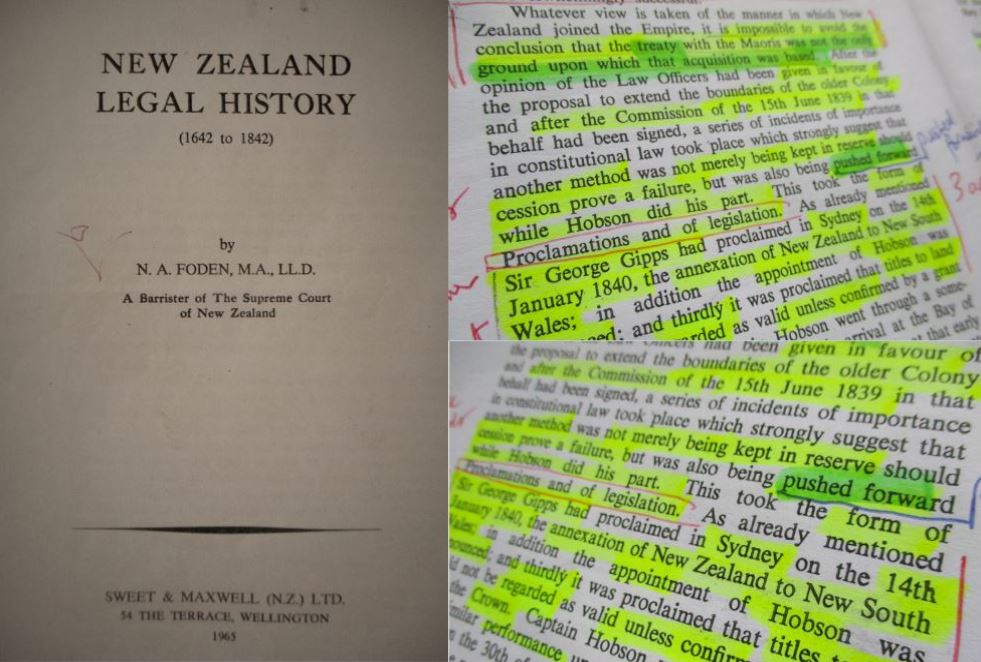
Contrary to current popular mythology, William Hobson did not forge a partnership between the British Crown and rangatira and chieftainesses of hapū and iwi in 1840.
This updated ‘partnership’ mythology is merely a reworked sanitized rendition of New Zealand’s violent state formation by the Second British Masonic Empire (1815-1918), that continues to stir the record in the whirlpool sensed by Prophet Papahurihia.
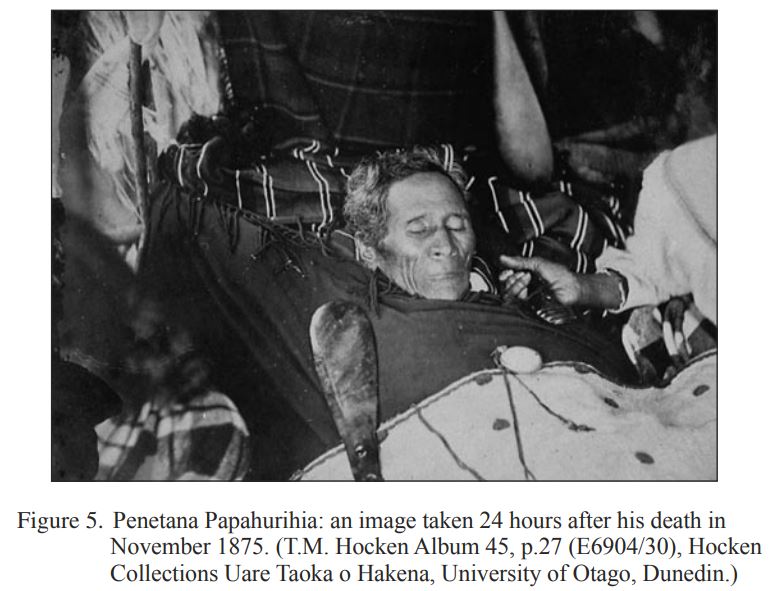
In making his observation in 1840 after the signing of Te Tiriti o Waitangi — Prophet Penetana Papahurihia had the foresight that the torgue Māori were then captured in, would last beyond 200 hundred years until a time when the truth would be commonly known and the legacy ofhidden tricks over-turned.
‘The who’, and ‘the why’ of ‘the how’ that whirlpool was stirred has been tracked back to its occult source: London.
This failure assists the Fourth British Empire (1945 to present) to maintain its hold over the South Pacific archipelago of Aotearoa New Zealand, as the apparent sole sovereign power, since the inheritors of that long-standing deception are the British Monarchy and their subversive allies.
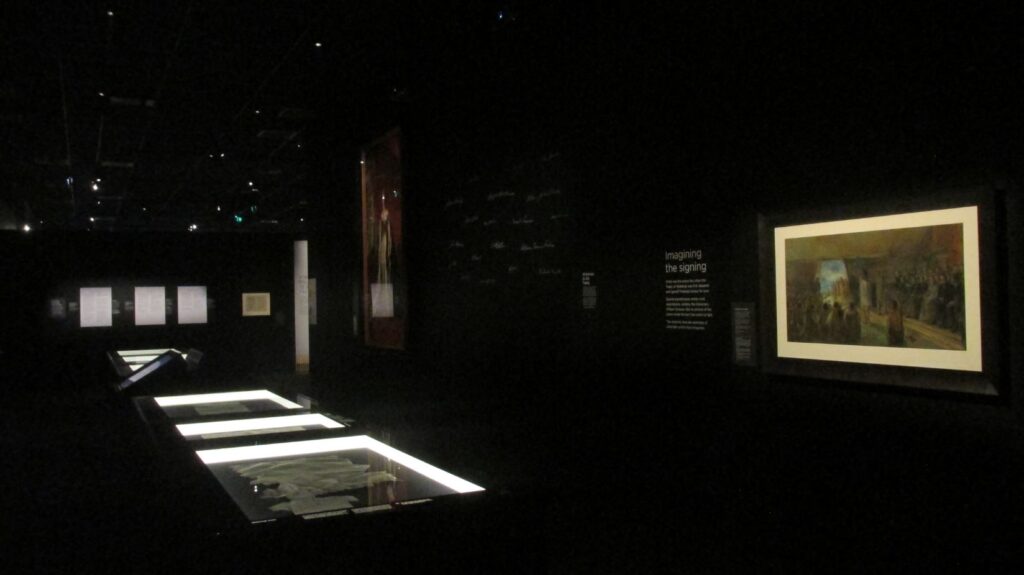
The novel twist of swindling full paper sovereignty from an entire people, was inflicted with the brazen expectation that a chiefly majority of signatories would not be gained by peddling the parchment copies around the coastline of the South Pacific Archipelago. The Waitangi Treaty Theater was, in effect, New Zealand’s second travelling theatrical production, staged to distract, divide and defeat the native race to work as red herring literary device to assist with the completion of the title claimed by Freemason Bro. Captain James Cook, during his the ‘Endeavour Voyage’ in 1769-1770.
Māori chiefs, hapū and iwi were manipulated by British agents, missionaries and other settlers, to trek along a track, through incremental steps, to the 1840 Waitangi Treaty, which was a theatre production that traversed the coasts of New Zealand — with unseemly speed.
In the pre-colonial era, many among the indigenous people of the South Pacific Archipelago,New Zealand, were led to believe that by their own agency in such steps, that they would retain their mana and tino rangatiratanga, or sovereignty authority, as self-determining people.
A revolutionary long-game was played, where time was ‘quickened’ around such events so that the British side achieved their objectives at every incremental step, amid set-backs, along two parallel tracks laid to form a colonial state. By weaponizing time dawn to dusk, and dusk to dawn, this periodically sped-up fourth physical dimension became the key mechanism to gain a new territory for the British Masonic Empire, until the job was ‘done and dusted’.
This truth has been concealed because the profundity of its impacts not only remains far-reaching, deep and brutal.
This profound truth of the parallel tracks — which were the linchpin of the scheme — is also the Achilles Heel of the British Monarchy, since the plan to take possession and sovereignty via the Colonial Law Track compelled hatching a devious plot. This deceptive scheme embroiled Queen Victoria in abetting a face-saving theater production designed to construe that the ‘Aboriginees of New Zealand’ had wittingly ceded all rights and powers of Sovereignty — forever.
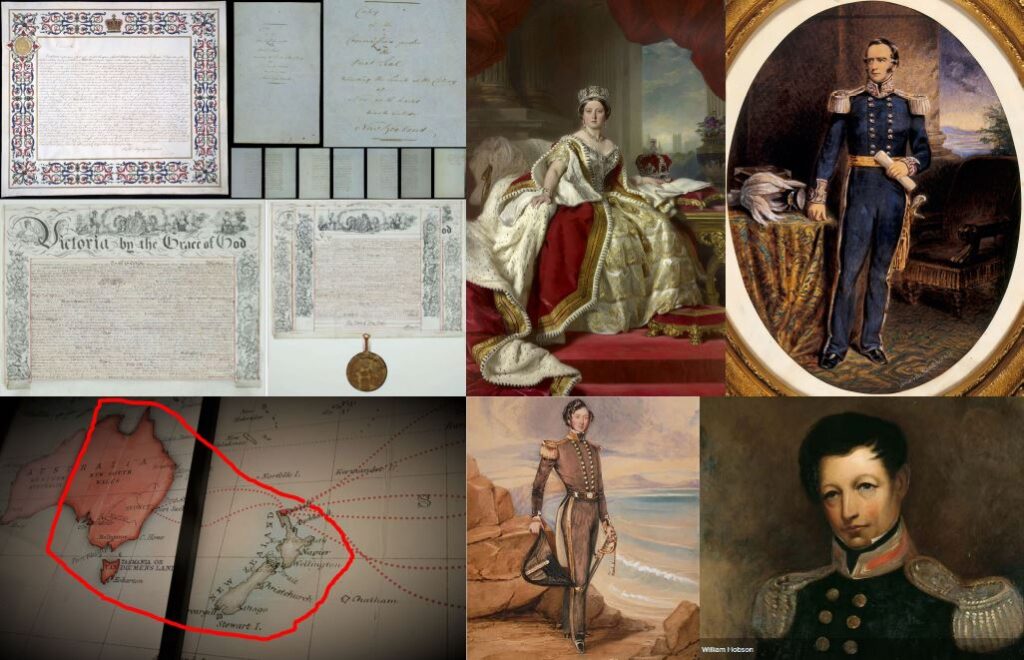
By weaponizing the one dimension that the British state could control — time — Britain’s masonic imperialists could circumvent the British Parliament by activating the Royal Prerogative Powers and thus avoid alerting other powers. The British Deep State had the advantage of coastal ship’s that could be deployed to get the Waitangi Treaty Tour done quickly, before too many Māori had time to realize the British were gaining paper sovereignty over the three dimensional space mapped by Freemason Captain Bro. James Cook.
The Royal Charter of New Zealand, dated 16th November 1840, actually sealed the swift double-track route laid to gain paper sovereignty by a series of legal moves consistent with English Constitutional Law, along the Colonial Law Track. The irony becomes potent when the rhetoric about the Queen being written into the preamble to make the treaty more comprehendible to the rangatira, can be seen for it what it was: a cover-story.
The Queen was written into the Treaty’s preamble because the Monarch’s authority was harnessed for the stealthy acquisition of New Zealand, effective June 15th 1839, when the Great Seal of United Kingdom was used to annex New Zealand and lasso the South Pacific archipelago to New South Wales like the islands were a herd of untamed cows that had ranged too far and it was time for milking. Therefore, the Queen’s named was deployed in the Treaty’s preamble as propaganda to emotionally hijack her target audiences: he tangata Māori.
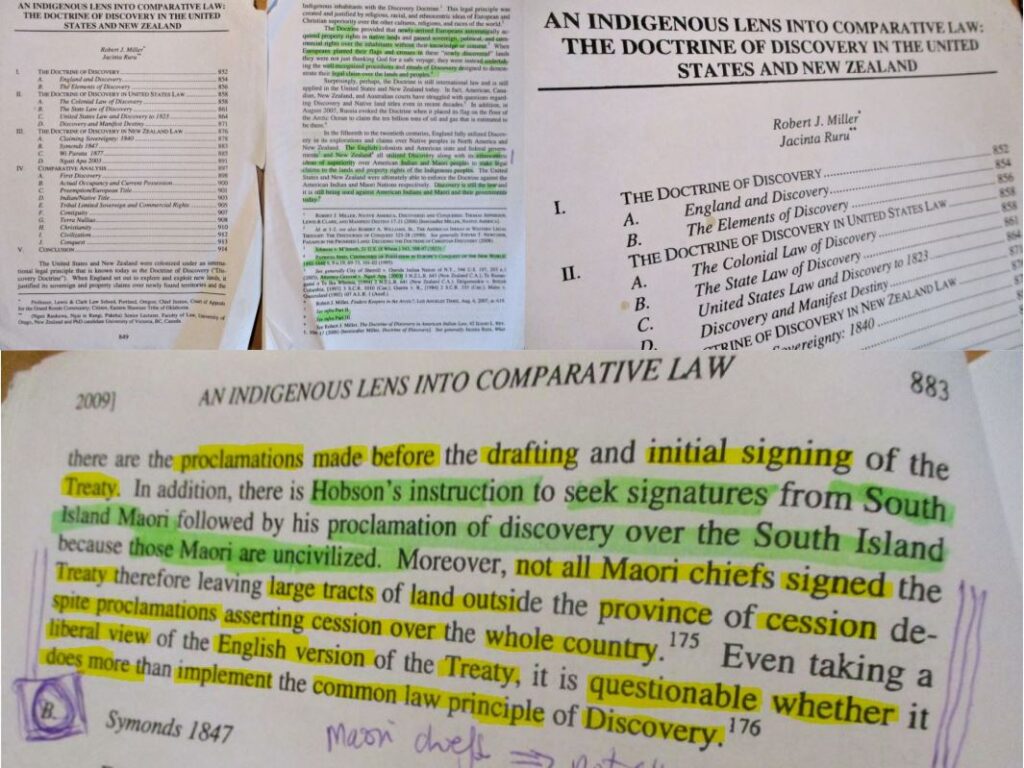
Queen Victoria’s name was also implicated in the commissions for New South Wales Governor George Gipps’ and William Hobson on July 30th 1839. Because that course of action required the exercise of Royal Prerogative Powers under the Great Seal of the United Kingdom, the newly laid Colonial Law Track would need a Royal Charter at the completion of the Treaty Tour journey.
Absent impartial legal representation on English Constitutional Law, a neutral political strategist voice acquainted in the layered British Masonic Empire and a detached historian, whom could supply critical imperial context about the cannon powers — Māori as a tribal people were out-played.
In 1840, the indigenous people of New Zealand — including those that could sense machinations were afoot, and either signed with great reluctance, or point blank refused, or were never ‘consulted’ — were all drawn into an unfamiliar game of imperial chess that the British and their agents, allies and enemies had been innovating for centuries.
=============

Key finding: The decision to opt for a Treaty was pursued to save face for the British Monarch, Queen Victoria, who authorized the perfect crime of power to swindle full sovereignty from an entire indigenous people by legal moves made upon the Colonial Law Track. The 1840 Waitangi Treaty was a red herring literary device hawked upon the Treaty Theater Track by the travelling ‘Treaty Theatre Company’. Ironically, this perfect power crime was itself a Deus Ex Machina chess move to win paper sovereignty over a new territory — with Royal Prerogative Powers, innovative political theater and weaponized time.
See the fully illustrated essay: Deep History of Waitangi: The Queen Victoria Connection >>
https://snoopman.net.nz/?p=20956
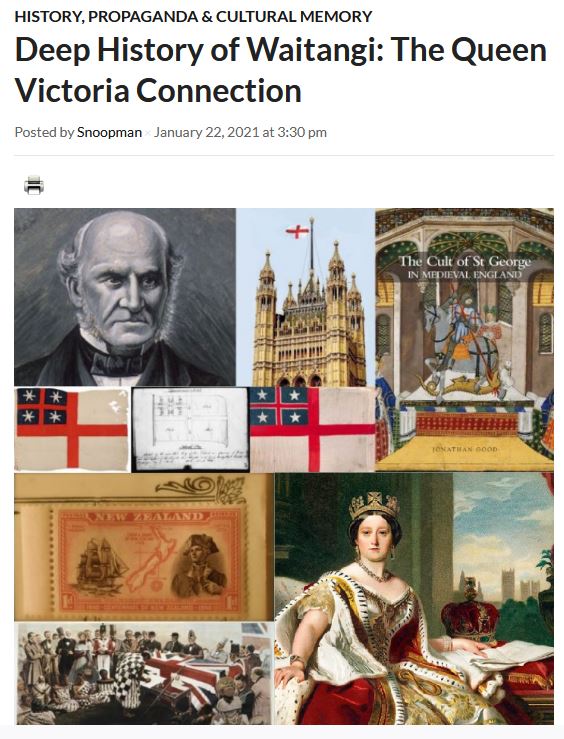
Steve ‘Snoopman’ Edwards is a dissident journalist, who worked at indigenous broadcaster, Māori Television, for 14 years as an editor of news, current affairs and general programmes. He forged his ‘Thunk Evil Without Being Evil’ super-power while writing his ground-breaking thesis on the Global Financial Crisis (GFC), titled – “It’s the financial oligarchy, stupid”– to figure out the means, modus operandi and motives of the Anglo-American Oligarchy.
Editor’s Note: If we have made any errors, please contact our administrator, Steve Edwards, with your counter-evidence. e: steveedwards108[at]protonmail.com
Selected Sources:
Miller, Robert J. & Ruru, Jacinta. (2009). An Indigenous Lens into Comparative Law: The Doctrine of Discovery in the United States and New Zealand, Vol. 111, 849-918. West Virginia Law Review.
Robert J. Miller. (2012). THE INTERNATIONAL LAW OF COLONIALISM: A COMPARATIVE ANALYSIS, p. 855-856. The Future of International Law in Indigenous Affairs: The Doctrine of Discovery, the United Nations, and the Organization of American States SYMPOSIUM. Lewis & Clark Law Review.
Waitangi Tribunal. (October 2014). He Whakaputanga me te Tiriti: the Declaration and the Treaty. Retrieved from: www.waitangitribunal.govt.nz
Te Kawariki & Network Waitangi Whangarei. (2012). Ngāpuhi Speaks: He Whakaputanga o te Rangatiratanga o Nu Tireni and Te Tiriti o Waitangi. Ngāpuhi Nui Tonu Claim. Commissioned by Kuia and Kaumātua of Ngāpuhi.
Emily Blincoe. (2015). “The Myth of Cession: Public Law Textbooks and The Treaty of Waitangi”, p. 8-9. Faculty of Law, Victoria University. Retrieved from: http://researcharchive.vuw.ac.nz/xmlui/bitstream/handle/10063/5021/paper.pdf?sequence
Claudia Orange. (1987). The Treaty of Waitangi. Wellington, New Zealand: Allen & Unwin Port Nicholson Press.
Matthew Wright. (2019). Waitangi: A Living Treaty.
Matthew S. R. Palmer. (2008). The Treaty of Waitangi in New Zealand’s Law and Constitution. Wellington, New Zealand: Victoria University Press.
Ruth Ross. (1972). Te Tiriti o Waitangi: Texts and Translations.
Anne Salmond. (2017). Tears of Rangi: Experiments Across Worlds. Auckland University Press.
Vincent O’Malley. (2014). Beyond the Imperial Frontier: The Contest for Colonial New Zealand.
Samuel D Carpenter. (November 2009). Te Wiremu, Te Puhipi, He Wakaputanga Me Te Tiriti – Henry Williams, James Busby, A Declaration And The Treaty, p.16-17. Report commissioned by the Waitangi Tribunal. Retrieved from https://forms.justice.govt.nz/search/Documents/WT/wt_DOC_1734955/Wai%201040%2C%20A017.pdf
J. I. Hetherington. (1926). New Zealand: Its Political Connection with Great Britain, Volume I, p. 75. Dunedin: New Zealand: Coulls, Somerville Wilkie.
Manuka Henare, Dr Angela Middleton and Dr Adrienne Puckey. (21st February 2013). “He Rangi Mauroa Ao te Pö: Melodies Eternally New”. Te Aho Claims Alliance (TACA): Oral and Traditional History Project Number: 23161.001. Mira Szászy Research Centre, The University of Auckland Business School. Retrieved from https://forms.justice.govt.nz/search/Documents/WT/wt_DOC_50129548/Wai%201040,%20%23E67.pdf
Richard S. Hill. (1986). Policing the Colonial Frontier: The Theory and Practice of Coercive Social and Racial Control in New Zealand, 1767-1867– Part One, p. 88-90. Wellington, New Zealand: Historical Publications Branch Department of Internal Affairs.
A. Foden. (1938). Constitutional Development of New Zealand in the First Decade (1839-1849). Wellington, New Zealand: L. T. Watkins Ltd.
N. A. Foden. (1965). New Zealand Legal History (1642-1842). Wellington, New Zealand: Sweet & Maxwell (N.Z.) Ltd.
Keith C. Hooper and Kate Kearins. (November 1, 2003). “Substance but not form: capital taxation and public finance in New Zealand, 1840-1859”. Retrieved from https://doi.org/10.1177/103237320300800206
William Barrett Marshall. (1836). A Personal Narrative of Two Visits to New Zealand in His Majesty’s Ship, Alligator, A.D. 1834. London James Nisbet & Co. Retrieved fromhttp://www.enzb.auckland.ac.nz/document/?wid=402&page=0&action=null
J. H Wallace. (1890). The Early History of New Zealand: From the Earliest Times to 1840.
Dom Felice Vaggioli. (2000 [1896]). History of New Zealand and its Inhabitants, Vol. II. Dunedin, NZ: University of Otago Press.
Tony Simpson (1986). Te Riri Pakeha: The White Man’s Anger. Auckland, NZ: Hodder and Stoughton.
James Belich (1998). The New Zealand Wars: And the Victorian View of Racial Conflict.
Snoopman. [25 April 2017] The Masonic New Zealand Wars: Freemasonry as a Secret Mechanism of Imperial Conquest During the ‘Native Troubles’. Retrieved from https://snoopman.net.nz/2017/04/25/the-masonic-new-zealand-wars/
Mark Hickford. (2011). Lords of the Land: Indigenous Property Rights and the Jurisprudence of Empire. Oxford University Press.
Peter Low (2011). Bishop Pompallier and Te Tiriti. In: The French Place in the Bay of Islands. Mātou Matauwhi.
Fletcher, Ned; Elias, Rt Hon Dame Sian — “A Collusive Suit to ‘Confound the Rights of Property Through the Length and Breadth of the Colony’?: Busby v White (1859)”. [2010] VUWLawRw 30; (2010) 41(3) Victoria University of Wellington Law Review 563. Retrieved from http://www.nzlii.org/nz/journals/VUWLawRw/2010/30.htm

